










2016 EDIBLE MONTEREY BAY
BEER GUIDE • LAVENDER SCMB’S EMILY THOMAS • KAYAK FISHING • POSTCARD FROM CUBA THE TERROIR OF TEA • PRICKLY PEARS AND NOPALES
CRAFT
Summer 2016 • Number 20
edible MONTEREY BAY
Monterey and San Benito Counties
Member of Edible Communities

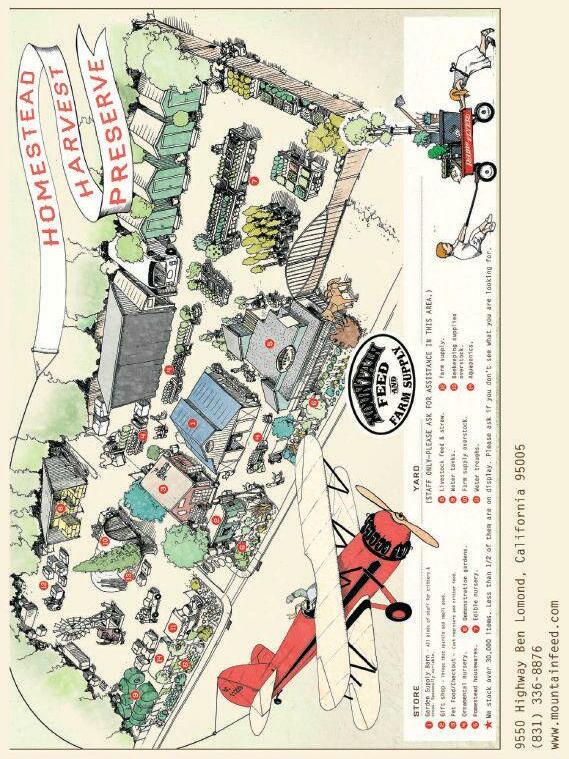
6 EDIBLE NOTABLES THE CURATED FEAST, FARM-TO-TEAPOT, POkE LAB, TOMATO LOVERS
SUMMER FARMERS’ MARkETS
WHAT’S IN SEASON NOPALES AND PRICkLY PEARS e dual-purpose cactus
POSTCARD FROM CUBA A California chef experiences the island nation’s changing food scene
46 THE PRESERVATIONIST ADD SOME FLAVOR TO YOUR JAMS! Okay, you know the basics. Now, let’s up your game
ON THE FARM DEERHAVEN LAVENDER FARM A family finds harmony with the land through lavender 55 DINE LOCAL GUIDE 67 LOCAL SOURCE GUIDE 72 LAST CALL LUNCH IN LISBON
BREWTOPIA
2016 Edible Monterey Bay CRAFT BEER GUIDE
Be sure not to miss this beautiful foldout map between pages 32 and 33.
RECIPES IN THIS ISSUE
19 Cactus and Kale Salad
20 Prickly Purple Heart Carnitas
22 Prickly Pear Summer Cooler
41 Smoked Black Cod Panuchos and Beer-Soaked Watermelon
48 Blueberry Mint Jam
EDIBLE HISTORY THE MCGRATH HOP A local heirloom revival story 34
A reminder that the soul of a place is found through its food—and its people
EDIBLE ENTREPRENEUR
LEADING LADY
How motorcycle mama Emily omas ignited the Santa Cruz craft beer explosion 42 SUMMER FORAGING kAYAk FISHING A day on the water hooks our writer
COVER ILLUSTRATION e Monterey Bay region by Zephyr Pfotenhauer
CONTENTS PHOTOGRAPH
Some of the delicious beer on offer at e Cremer House, Felton, by Michelle Magdalena
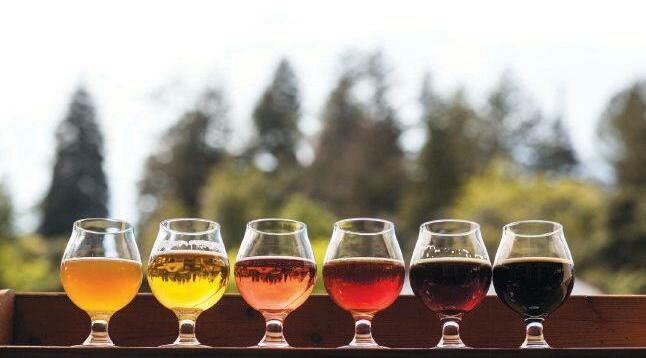
Additional recipes online at www.ediblemontereybay.com/recipes:
Moroccan Couscous Salad with Lavender Lemon Tahini Dressing, Strawberry Lavender Tart and Lavender Lemon Vinaigrette.
2 edible monterey baysummer 2016
4 GRIST
14
16
24 EDIBLE TRAVEL
30
51
Contents

GRIST FOR THE MILL
monterey bay
PUBLISHER AND EDITOR Sarah Wood
Sarah@ediblemontereybay.com 831.298.7117 or 831.238.1217
CO–PUBLISHER AND ASSOCIATE EDITOR Rob Fisher DEPUTY AND DIGITAL EDITOR Deborah Luhrman

COPY EDITOR Doresa Banning
LAYOUT DESIGN Melissa Petersen
EDITORIAL/PRODUCTION ASSISTANTS
Rosie Parker • Katie Reeves
Food gives us comfort, and perhaps that’s why, as much as we love new adventures, we fall into a rut sometimes when it comes to our culinary experiences. ere is a restaurant only a few blocks from our house that is often our go-to place when we are just too tired to cook. e waitress (always the same woman) greets us like we are Norm from Cheers, and doesn’t even bother to hand us a menu because we always order the same thing.
ere are times to stay on familiar, soothing turf, but there are also times to venture out and have new experiences!
is issue is all about exploration. Chef and writer-photographer John Cox takes us to Cuba on the eve of its opening to American tourism (p. 24); Jamie Collins explores the cooking possibilities of nopal cactus and its prickly paddles and fruit—food that grows all around us but that few of us have dared to cook, perhaps because of those spines (p. 16); Rosie Parker hits the bay with avid kayak fishermen and discovers a new passion (p. 42); and Amber Turpin delves into a dinner series called e Curated Feast that brings participants back in time to explore history through eating (p. 6). Patrice Vecchione takes you to a farm where you may pick your own lavender this summer—and cook with it (p. 51).
We also feature some of our local beer mavens who refuse to get caught in the routine of making the same old familiar brews. Emily omas of Santa Cruz Mountain Brewing and e Cremer House is building a larger local beer community with every new experiment (p. 34), and Luke Taylor of Corralitos Brewing Co. has revived for his brews—and the community—a beloved hop which traces its local heritage back to the 1800s (p. 30).
Speaking of beer, if you read our weekly newsletter (subscribe for free at www.ediblemontereybay.com), you know that our local beer scene is exploding. To help us all explore it, we are including between pages 32 and 33 of this issue a beautiful removable one-of-a-kind guide to where to find them all. Big kudos to Zephyr Pfotenhauer and Rosie Parker for creating it.
e best thing about getting out of a rut is that it opens our eyes as well as our taste buds. Since editing this issue, the rockfish and lingcod we get in our weekly Real Good Fish share has become something we, too, could catch, and Monterey Bay has been transformed from a pretty view to a place where we could launch kayaks to catch that fish. And that roadside cactus we pass every day? We’re suddenly watching its fruit for signs it’s ready to pick!
We hope this edition of Edible Monterey Bay makes you see our area and its food in a whole new way, and that it inspires some exciting new experiences this summer. Tell us about them by writing to info@ediblemontereybay.com or post images of them on Instagram with the hashtag #ediblemontereybay and we’ll consider them for publication in our fall issue!
Happy exploring,
Publishers
AD DESIGN Bernard Fernandez • Bigfish
Smallpond Design • David Ball • Dina Clark
Jane Bolling Design • Marilet Pretorius Melissa oeny Designs
CONTRIBUTORS Angela Aurelio
Jordan Champagne • Jamie Collins
John Cox • Zoe Fisher • Elizabeth Hodges
Michelle Magdalena • Camilla M. Mann
Kathryn McKenzie • Rosie Parker • Zephyr
Pfotenhauer • Mike Santaella • Carole Topalian Amber Turpin • Patrice Vecchione • Patrice Ward
ADVERTISING SALES
ads@ediblemontereybay.com • 831.298.7117
Shelby Lambert 831.238.7101

Kate Robbins 831.588.4577
Ola Rocha 802.734.7635 Sarah Wood 831.238.1217
DISTRIBUTION Mick Freeman
SOCIAL MEDIA MANAGER Katie Reeves
CONTACT US:

Edible Monterey Bay P.O. Box 228, Carmel Valley, CA 93924 www.ediblemontereybay.com 831.298.7117 or 831.238.1217 info@ediblemontereybay.com
Edible Monterey Bay is published quarterly. All rights reserved. No part of this publication may be used without written permission of the publisher. Subscriptions are $28 per year at www.ediblemontereybay.com. Every effort is made to avoid errors, misspellings and omissions. If, however, an error comes to your attention, please accept our apologies and notify us. We also welcome letters to the above address. ank you.
4 edible monterey baysummer 2016
Sarah Wood and Rob Fisher
Photo by Zoe Fisher
edible

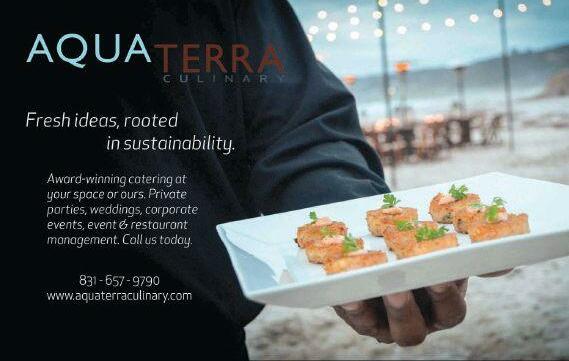
www.ediblemontereybay.com 5
EDIBLE NOTABLES THE CURATED FEAST

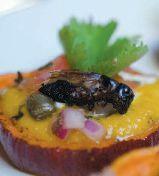
e conscious eater’s local event series
BY AMBER TURPIN PHOTOGRAPHY BY ELIZABETH HODGES AND ROB FISHER
It’s an accomplishment to embrace all five senses when you eat. It takes focus and diligence. But Liz Birnbaum, creator of e Curated Feast, a high-concept event series based in Santa Cruz, doesn’t just believe in slowing down to taste, smell, hear, feel and see her food. She also practices a sixth sense, if you will, which is experiencing a place in time. Her aim is to take you on this time travel, with food and drink being your mode of transport, and a group of other engaged eaters being your companions.
“It all started almost as a party trick,” she says of her unique outlook and ability to articulate the historical and anthropologic pathways of ingredients. “I would tell stories over drinks with friends.” But it soon became obvious that there was a bigger calling for this talent.
And so, drawing on diverse experience in the food and farm worlds (her beloved current day job is with the Organic Farming Research Foundation), Birnbaum launched e Curated Feast in June 2015 at Event Santa Cruz.
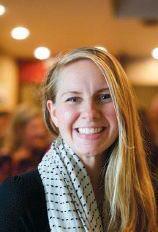
Since then, Birnbaum has hosted more than a half-dozen parties, pop-ups and speaking events, using menus, ingredients, storytelling, props and some theater to explore the supposition that every ingredient has historical meaning that is significant to us today.
“Not everybody is into this kind of didactic feast,” she admitted while staging one of her most recent dinners, 1493—A Feast of Origins, in March. It was her third event tracing cultural history through food, beginning with e Taste of Ancient Greece Feast last July, and following e Silk Road, A Traveler’s Feast, in October.
It takes a certain kind of person who is more than a little bit interested in food to really get into what e Curated Feast is all about. But those of us who geek out on the stories and the linking of history to what we eat are diehard fans. In fact, most people who have attended one of her events are now regulars, waiting for the next delicious journey.
is particular meal, which took place in the upstairs Mo tiv bar in downtown Santa Cruz, now home to LionFish SupperClub’s Ulterior, took guests over continents as well as through time. “e idea of a New World and an Old World being separate is a very European imperial concept, an illusion,” explains Birnbaum. LionFish co-owners Zachary Mazi and Tighe Melville have been partners and collaborators with Birnbaum since the beginning. Like Birnbaum, they love the process of coming up with a symbolic menu to fit the events’ themes.
To illustrate what e Curated Feast presents, here’s an example. To begin the 1493 meal, we were served a Botanical Imperial Cocktail,

6 edible monterey baysummer 2016
a gin and tonic designed as an “emblem of complex trade,” Birnbaum said. e Bombay Sapphire was meant to illustrate Britain’s crown jewel. Both malaria and scurvy were huge issues facing early global trade, so the tonic water’s relevance came from the quinine—a medicine used to prevent malaria—that it contains, and the lime, from its vitamin C, which addresses scurvy. e Ass am tea simple syrup in the drink referenced the tea battles between China and England, and sugar, native to New Guinea and produced with forced labor, was a reminder of the integral role of slavery in the period.
ere were seven more courses to ponder, equally layered in meaning. All of this learning while eating very much cultivates conversation, a focus on the relevance of what we are feasting on a nd a reverence for it, which is really the point of all of it. Birnbaum is encouraging us to look deeper, to keep pulling at the thread, the story, the exploration, transforming the way we eat.
ere are many more curated food adventures to come, starting with a traveling feast on June 19 in San Francisco. is may be the beginning of more on-the-road endeavors, possibly with internationally known chefs overseas. Food matters everywhere, but the points of reference are different. Taking the concept of storytelling through a meal to different audiences and seeing how it might resonate in different cultures excites Birnbaum.

Meantime, sign up for Birnbaum’s newsletter to find out when her next local event will happen. Her most recent research has focused on flower mythology, the history of winemaking and more botanical imperialism…all of which will continue to bubble up in a variety of outlets both near and far. Also still simmering is a look at our local food heritage and history close to home.
Amber Turpin is a freelance food and travel writer based in the Santa Cruz Mountains.
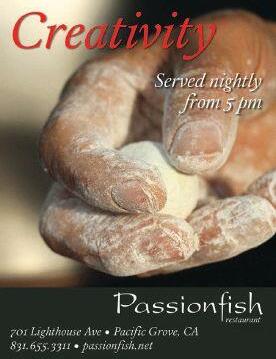
e Curated Feast thecuratedfeast@gmail.com • 847.275.0121 • www.thecuratedfeast.org
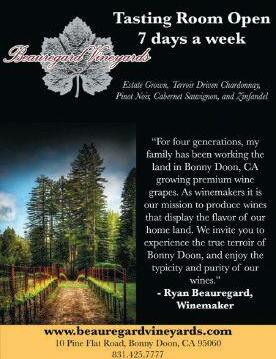
www.ediblemontereybay.com 7
EDIBLE NOTABLES TERROIR OF TEA

e farm-to-teapot tisanes of San Benito Tea Co.
BY ROSIE PARKER PHOTOGRAPHY BY PATRICE WARD
Sara Steiner, owner of San Benito Tea Co., believes in the terroir of tea.

When she started her business in 2012, Steiner, a winemaker at Gabilan Wine Co. with more than 30 years of experience, chose to approach tea like she approached wine. “My first focus is on the plants— the growing—on where I am,” she says.
At ree Horse Farms, her property in the beautiful wine-centric Cienega Valley of Hollister, Steiner grows more than 50 herbs for her custom-blended herbal teas, properly known as tisanes. Her cultivars range from the familiar, like chamomile, to the more exotic, like jiaogulan, which is similar to ginseng.
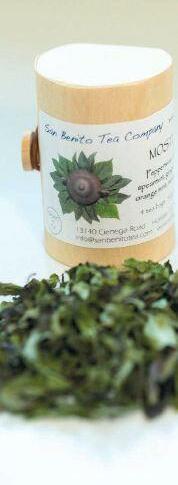
Each year there is a-trial-and-err or process to find what herbs, both native and imported, thrive best with her growing conditions. “Terroir—that’s what this is about. at’s the focus and that’s the discovery.”
e results are extremely fresh, vibrant, unadulterated teas. Steiner says each offers a taste, smell and sensation that is “a pure and honest expression” of the plants they come from.
8 edible monterey baysummer 2016
Steiner creates her herbal infusions with an acute awareness of the health benefits of each herb, but flavor is a major factor.
“Once I’ve matched up the medicinal properties, I try to make blends that are balanced yet complex,” Steiner says over a smooth and energizing pot of her adaptogenic brew, Morning Cup. “Like wine, that relationship of balance and complexity is what mak es something really interesting.”
Steiner’s Limón Lemon Citron is a satisfying and surprisingly balanced brew in which the herbaceous lemongrass and lemon thyme are complemented by the sweetness of lemon verbena and the bitterness of lemon balm and lemon zest. Raspberry leaf and monarda, a member of the mint family, round out the palette.
With so much feedback about people’s sleep troubles, Steiner created her best seller, a salubrious brew called Good Good Night. is blend promotes a restful sleep with tulsi, lavender flowers, wild lettuce and, acting as a calming sedative, California poppy.
Steiner also loves staying in one herbal family, as with her Mostly Mint blend, which includes four different kinds of mint and shows consumers the range of a common ingredient.
No matter the blend, customers can know that unlike the products of some big commercial tea companies, Steiner’s contain no additives. e ingredients are not only pure and local, but they have been estate grown according to organic methods and hand-harvested and hand-packed in the form of whole leaves as much as possible, thereby limiting oxidation. And they’re never older than the last harvest season.
is attention to freshness means that before the annual harvest season ramps up in May, visitors at Steiner’s farmers’ market booths in Monterey, Oakland and Palo Alto (and customers who order online) may find some of her popular teas are sold out. But come summer, her inventory rises again.
“e farmers’ market is the perfect place for this,” Steiner says. “Once people approach you as a farmer, there’s less expectation that you’re going to have everything all of the time. ey understand that you’re tied to the climate, the season, your land. And they understand that, as a result, they’re getting a product that is much more vibrant and fresh.”
Steiner works mostly on her own with the invaluable help of WWOOFers whom she hosts for much of the year. Given the laborintensive nature of her product, she’s happy for her company to maintain its intimate scale.

“is is a luxury for me,” Steiner says thoughtfully, reflecting on the journey from seeding to steeping. “I can walk from my garden to the market. I can pour someone tea and say that it was just harvested that week. I can say this is mine.”
San Benito Tea Co. 831.638.4843 • info@sanbenitotea.com • www.sanbenitotea.com
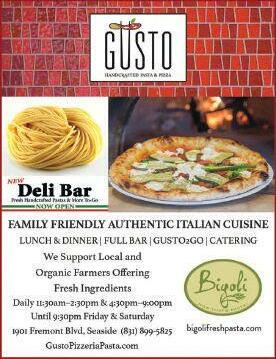
Rosie Parker, a native New Englander, likes to complain of missing home while living the Santa Cruz highlife—surfing, hiking, writing and working for a delicious craft brewery.
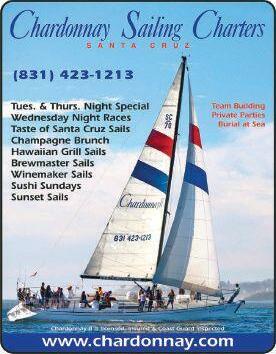
www.ediblemontereybay.com 9
EDIBLE NOTABLES THE POKE LAB
Healthy, high-quality fast food finds a foothold in Monterey STORY
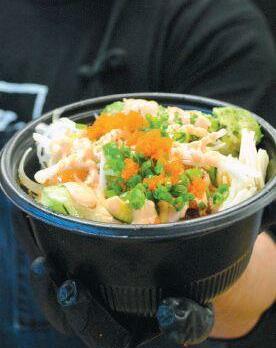
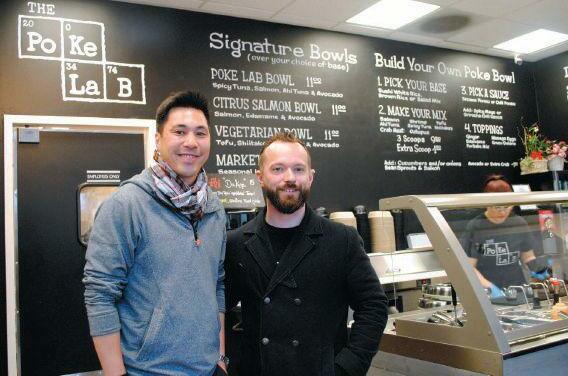
AND PHOTOGRAPHY
BY CAMILLA M. MANN
Restaurateur Joey Nguyen opened e Poke Lab earlier this year with the goal of delivering something still relatively uncommon in downtown Monterey: fresh, light and sophisticated fast food made from local ingredients that would match the community’s yen for high-quality dining options.
“ere aren’t many choices on a lunch break besides burgers or burritos,” explains executive chef James Anderson. “Not everyone has an hour to sit down. We’re quick with an approachable price.”
Some other imports that the restaurant has brought to the downtown Monterey food scene are youth—Nguyen is just 33 and Anderson, 28—as well as hipness: you might think you were in San Francisco when you see the line going out the door.
10 edible monterey baysummer 2016
Fresh additions to the Monterey food scene: From left, Joey Nguyen and James Anderson; below, the Poke Lab Bowl.
But since speedy service is a key part of e Poke Lab’s reason for being, Nguyen and Anderson make sure the queue moves fast—during lunch, I was 12 deep in a line that snaked outside, yet I was eating within 15 minutes.
“Even with a long line,” says Nguyen, “people get through quickly.”

What’s more, soon Nguyen and Anderson will unveil grab-and-go options so that customers can skip the line altogether. ey’re just working out how to package them in an earth-friendly way.
Traditionally, poke—pronounced “POH-kay,” meaning “to slice into pieces” is a fish salad. Native Hawaiians sliced raw fish, mixing in salt, seaweed and chopped kukui nuts. Hawaiian fish markets, where Monterey native Nguyen discovered poke on trips to visit family, all have their own recipes; endless variations in flavors and textures exist.
e Poke Lab’s three signature bowls are the Poke Lab, with spicy tuna, ahi tuna, salmon and avocado; the Citrus Salmon, with edamame and avocado; and the Vegetarian, with tofu, edamame, shiitakes and avocado. e Market Bowl changes with the seasons, and the I’ll Leave it to You is a chef’s choice, which Anderson can use to test new items.
Diners can also order the Build Your Own bowl. Like an artist’s palette, the array of choices provided by the restaurant includes carmine ahi, vibrant orange masago (capelin roe), purple-tinged tako (octopus) and creamy green avocado.
It may seem surprising for Anderson, whose previous gigs at Affina Food + Wine and La Bicyclette in Carmel were more fine dining in emphasis, to decide to head a casual kitchen.
But his first local job wa s at Roy’s, where he prepared sashimi. Fine-dining touches to the poke bowls include from-scratch sauces and dressings. And, to minimize waste, Anderson house-cures salmon belly bacon with the leftovers from the salmon they prep.
rough established relationships, Anderson is connecting local purveyors to e Poke Lab. ough daikon isn’t traditional, Anderson uses daikon from Hollister’s Coke Farm as an onion alternative. Moss Landing’s Monterey Bay Seaweeds grows seaweed specifically for him. With desired characteristics in mind, they settled on ogo, a sea moss eaten in coastal Japan and Hawaii. Real Good Fish’s smoked black cod will be e Poke Lab’s first cooked fish option.
ough e Poke Lab is still new, it’s already developed a fierce following. Customers from Carmel make the trip over the hill several times a week.
“It’s not just about the food,” says Nguyen. “I want people to come, see a smiling face and have a great experience.”
One customer echoed that sentiment.
“We’ve probably been here eight times since they opened,” says Brian Garneau. “It’s consistent and the quality is always fresh.”
Camilla M. Mann is a food writer, photographer, adventurer and passionate cook. She blogs at culinary-adventures-with-cam.blogspot.com and lives in Seaside.
e Poke Lab
475 Alvarado St., Monterey • 831.200.3474 • www.thepokelab.com

www.ediblemontereybay.com 11
EDIBLE NOTABLES TOMATO LOVERS
Meet the folks trying to change the world one tomato at a time
BY DEBORAH LUHRMAN PHOTOGRAPHY BY DEBORAH LUHRMAN AND CAROLE TOPALIAN
Farmer Cynthia Sandberg barely noticed the first time realtor Helen Pastorino came to one of her gardening classes at Love Apple Farms in the Santa Cruz Mountains and offered to sit down and talk business.
“Sometimes you’ve got to hit me over the head with a two-by-four to get me to pay attention,” she admits.
But then Pastorino took another class and persisted.
“I realized that this was a really high-powered businesswoman, and we entered into a relationship where she became my mentor,” says Sandberg. “She’s just vastly more experienced in business than I am and a lot more successful.”
So the teacher became the student, with Pastorino—who founded the Los Gatos-based Alain Pinel and Pertria real estate groups—guiding Sandberg toward her dream of creating a community of tomato lovers in the World Tomato Society.
WTS was actually launched two years ago, but Sandberg was busy growing gourmet vegetables for David Kinch’s Michelin-starred Manresa restaurant, and the project needed a reboot.
In January, tech entrep reneur Bud Michael was brought on board as the society’s CEO and in March Sandberg ended her partnership with Manresa to devote more time to the tomato society. She and Michael have also joined forces with Gary Ibsen and his wife Dagma
Lacey, who run the TomatoFest seed company and from 1990 to 2008 organized the popular Carmel TomatoFest.
“I did a bunch of research and found tomatoes are a huge industry,” says Michael, who at first was apprehensive about the business potential. “It’s a $21 billion-a-year industry and millions of people are passionate about tomatoes, but nobody’s really organized the world of tomatoes.
“I thought about how Etsy and Craftsy and even Pinterest when they began were all affinity groups, started around a particular theme of interest,” he says.
Cooking and gardening are the top two hobbies in the United States and tomatoes, although technically a fruit, are considered the most widely grown vegetable. So the ingredients are there for a successful society that brings together growers, gardeners, nutritionists, chefs, home cooks and eaters from around the globe.
“e tomato crosses all boundaries and cuisines and all socioeconomic boundaries as well,” says Sandberg, who ha s been growing tomatoes “passionately” for the past 20 years and holds an annual tomato plant sale every spring in Scotts Valley.
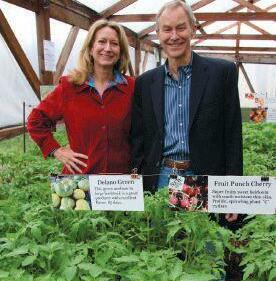
“When home gardeners start a vegetable patch, tomatoes are their number one most desired thing to grow, because the difference in fla-
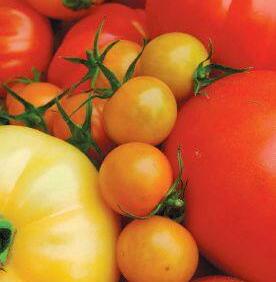
12 edible monterey baysummer 2016
e World Tomato Society’s Cynthia Sandberg and Bud Michael
Photo at left by Carole Topalian, photo at right by Deborah Luhrman
vor between a homegrown tomato and a store-bought tomato is so significant,” she adds.
e World Tomato Society is set to blossom into a virtual online community packed with tutorials and videos on growing and cooking with tomatoes, sustainable living, health research and an encyclopedic catalog of all known tomato varieties.

Award-winning Monterey graphic designer Jerry Takig awa has been tapped to create the new WTS website.
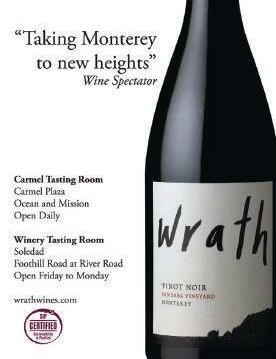

Ibsen is charged with fleshing out and expanding the catalog, which currently includes 5,800 tomato varieties with color photos and is being converted into a database that allows users to search for the exact color, shape, size and growing profile they want. Most content is available only to members of the World Tomato Society, but membership is free with registration.
“It’s painstaking work, but I enjoy it all,” says Ibsen. “I’m in touch with almost all the international seed companies and with individual families who have been holding on to their heirloom seeds for generations and want to share them with the world.
“I love it because I’m always learning about plant history, family history and cultural history. e stories are just as important as th e fruit itself,” he adds.
And bringing back Ibsen’s TomatoFest is certainly in the cards.
“It was magical, it was awesome,” recalls Sandberg. “People really want him to bring it back. Now, through the WTS he’ll have help doing it.”
e collaborators are aiming to revive TomatoFest in 2017 and the first reiteration will likely take place in Los Gatos, where the WTS headquarters has been set up in Pastorino’s office building. Later, they hope to establish tomato festivals in cities around the world.
Back at Love Apple Farms, Sandberg is overseeing the research arm of the society, pursuing such projects as debunking myths about tomato gimmicks that she says do not work, like the topsy-turvy tomato plant, the tomato tree and ketchup and fries—a tomato-potato plant combo.
She will also conduct tomato trials and work on starting a seed bank to preserve heirloom varieties.
Michael is forging a variety of partnerships to gain financial stability and credibility. Among the first partners are Enza Zaden, the Dutch seed company with U.S. headquarters in Salinas, the Tomato Foundation of Barcelona, Spain and the Demeter Association for biodynamic certification.
“Our short-term objective is to let people know we’re h ere, build a membership, add content and build up the World Tomato Society brand,” he says. “But the ultimate goal is to create a credible voice so that we can really advance the cause of sustainable living. ere are lots of ways to go with this, but it all starts with the tomato.”
Deborah Luhrman is deputy editor of Edible Monterey Bay and editor of our weekly newsletter. A lifelong journalist, she has reported from around the globe, but now prefers covering our flourishing local food scene and growing her own tomatoes in the Santa Cruz Mountains.
www.worldtomatosociety.com
www.ediblemontereybay.com 13
MONDAY
Monterey Fairgrounds Certified Farmers’ Market
9am–5pm • Year-round • 2004 Fairgrounds Road, Gate 8 831.235.1856
Pacific Grove Certified Farmers’ Market
3–7pm • Year-round • Central and Grand avenues 831.384.6961 • www.everyonesharvest.org
Alisal Certified Farmers’ Market
11am–4pm • June–September • Gabby Plaza, 632 E. Alisal St. 831.384.6869 • www.everyonesharvest.org
Carmel Certified Farmers’ Market at e Barnyard
9am–1pm • May–September • 3690 e Barnyard 831.728.5060 • www.montereybayfarmers.org
Felton Farmers’ Market
2:30–6:30pm • May–October • 120 Russell Ave. at Hwy. 9 831.454.0566 • www.santacruzfarmersmarket.org
Old Monterey Marketplace Farmers’ Market
4–8pm • Year-round • 831.655.2607 • www.oldmonterey.org
Alvarado Street between Del Monte Avenue and Pearl Street
UCSC Farm & Garden’s Market Cart
noon–6pm • June–October • 1156 High St. at Bay St. 831.459.3240 • www.casfs.ucsc.edu
Hollister Certified Farmers’ Market
3–7:30pm • May–September • San Benito Street 831.636.8406 • www.downtownhollister.org
King City Farmers’ Market
4–7pm • May–October • Broadway Street 831.385.3814 • www.kingcitychamber.com
Natividad Medical Center Farmers’ Market
11am–3:30pm • mid-May–October • 1441 Constitution Blvd. Salinas • 831.384.6961 • www.everyonesharvest.org
Downtown Santa Cruz Farmers’ Market
1:30–6:30pm • Year-round • Lincoln and Cedar streets 831.454.0566 • www.santacruzfarmersmarket.org
Boulder Creek Farmers’ Market (note: new day/time)
2:30–6:30pm • April–October • Forest and Pine streets 831.338.7262 • farmersmarketbc@gmail.com
Carmel-by-the-Sea Certified Farmers’ Market
10am–2pm • Year-round • 6th Avenue 209.549.6434 • www.gsfma.org
North County Farmers’ Market
2pm–dusk • Year-round • 11261 Crane St., Castroville 831.633.3084 • www.ncrpd.org
Soledad Farmers’ Market
4–8pm • May–September • Front and Soledad streets 831.261.6737
FRIDAY SATURDAY
Monterey Certified Farmers’ Market
10am–2pm • Year-round • 980 Fremont St. 831.728.5060 • www.montereybayfarmers.org
Salinas Valley Memorial Health Care Farmers’ Market
1:30–5:30pm • mid-May–October • 450 E. Romie Lane 831.384.6961 • www.everyonesharvest.org
UCSC Farm & Garden’s Market Cart noon–6pm • June–October • 1156 High St. at Bay Street 831.459.3240, www.casfs.ucsc.edu
Watsonville Certified Farmers’ Market
3–7pm • Year-round • Peck and Main streets 831.588.7366 • watsonvillecfmarket@gmail.com
Aptos Certified Farmers’ Market
8am–noon • Year-round • 6500 Soquel Drive 831.728.5060 • www.montereybayfarmers.org e Oldtown Marketplace Farmers’ Market
9am–2pm • Year-round • Main and Gabilan streets, Salinas 831.758.0725 • www.theoldtownmarketplace.com
Westside Santa Cruz Market
9am–1pm • Year-round • 2801 Mission St. 831.454.0566 • www.santacruzfarmersmarket.org
Scotts Valley Farmers’ Market 9am–1pm • April–November • 360 Kings Village Road 831.454.0566 • www.santacruzfarmersmarket.org
SUNDAY
Carmel Valley Certified Farmers’ Market
10am–3pm • Year-round • 77 W. Carmel Valley Road 650.290.3549 • www.westcoastfarmersmarkets.org
Seascape Village Certified Farmers’ Market 11am–2pm • May–October • Seascape Village, Aptos 831.685.3134 • www.seascapevillageshops.com
Marina Certified Farmers’ Market 10am–2pm • Year-round • 215 Reservation Road 831.384.6961 • www.everyonesharvest.org
Del Monte Certified Farmers’ Market
8am–noon • May–October • 1410 Del Monte Ctr., Monterey 831.728.5060 • www.montereybayfarmers.org
Live Oak/Eastside Farmers’ Market 9am–1pm • Year-round • 21511 E. Cliff Drive, Santa Cruz 831.454.0566 • www.santacruzfarmersmarket.org
Watsonville Fairgrounds
Certified Farmers’ Market 9am–4pm • Year-round • 2601 E. Lake Ave. • 831.235.1856
14 edible monterey baysummer 2016
TUESDAY WEDNESDAY THURSDAY
WIC EBT WIC EBT WIC WIC EBT MM WIC EBT WIC EBT WIC EBT WIC EBT WIC WIC WIC EBT WIC EBT WIC EBT WIC EBT WIC EBT WIC EBT WIC EBT WIC WIC SUMMER FARMERS’
RESEARCH BY AMBER TURPIN MM
MARKETS
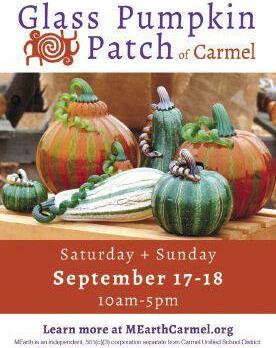
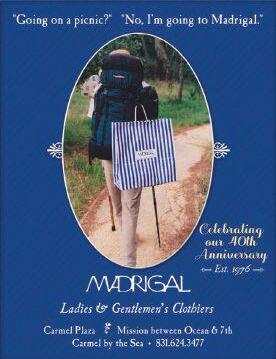
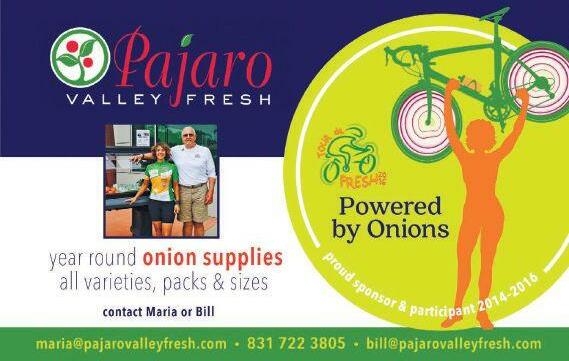
www.ediblemontereybay.com 15
WHAT’S IN SEASON NOPALES AND PRICKLY PEARS
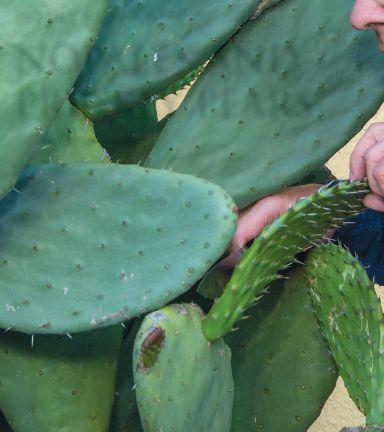

e dual-purpose cactus
BY JAMIE COLLINS
16 edible monterey baysummer 2016
Manfred Warmuth harvests a cactus paddle from his garden.
Ever notice large stands of cactus with hot pink fruit growing randomly alongside farm fields in the Monterey Bay area? ese are nopal cactus, native to Mexico and planted by farm workers who brought them here from their home country. With uses that range from a hangover remedy to a blood sugar regulator, this prickly succulent is finally getting some recognition, thanks to a few creative local food and drink producers who take on the tough job of spine removal, and turn the paddles and the sweet fruit into brilliant products.
HISTORY
e Opuntia cacti, commonly called nopales in Spanish, refers to the fleshy cactus pads that bear sweet-tart magenta fruit called tuna in Spanish, and prickly pears in English. ere are about 115 known nopales species native to Mexico, most of them edible. Opuntia ficus-indica and Opuntia joconostle are the two most often farmed.
Nopal cactus is abundant in Central Mexico and a common ingredient in Mexican dishes and traditional medicine. However, most of the nopal grown in Mexico is fed to livestock. Farming of nopal provides Mexican communities with work, food and income, allowing them to afford to stay on their land. For hundreds of years nopal has been a staple in the diet of Latin Americans and is so coveted that the Mexican flag has a prickly pear cactus on it.
e liquid inside the paddles and the juice from the fruit also provide a hydrating source for both humans and animals in the arid regions. Native Americans used prickly pears to make colonche—a fermented alcoholic beverage—and rarer varieties of the cactus possess small amounts of mescaline, a psychotropic substance.
Here in the States, the nopal cactus was mostly planted by rogue propagators, and luckily they knew the very best variety to plant, says Tabitha Stroup, owner of Friend in Cheeses Jam Co. in Soquel. e hot pink Mexican prickly pears are the tastiest around, delivering a tart-sweet, bright flavor and high tannic acids. ere is also a Spanish yellow variety that can be found l ocally but doesn’t grow as well as the magenta fruiting cactus because it prefers ashy, volcanic soils. Stroup uses the Mexican fruits in her Prickly Purple
Heart Jam, from which part of the proceeds benefits Jacob’s Heart Foundation.
Stroup is a wealth of knowledge about the nopal cactus and how to deal with the gnarly spines of both the pads and fruit. For using the fruit in juices or marmalades, she suggests wearing gloves that go up to your elbows. Without removing the spines, put the ripe prickly pear fruit through a juicer whole and strain it as the seeds are also a concern— they are so hard they can break a tooth if they are passed on to the finished product.
A big-time local producer of prickly pears is Salinas-based D’Arrigo Brothers, packing under the Andy Boy label. e D’Arrigo fruits are sol d under the name cactus pears, perhaps to help consumers forget the spines, which are removed with a special machine, leaving no trace of them on the fruit. Founders of D’Arrigo Brothers came from Sicily, where 10,000 acres of prickly pears are in production.
Nopal cactus pads are eaten when they have new, tender growth in the spring through summer. e fruit is harvested summer through fall. When harve sting, wear thick gloves and use tongs to hold the cactus pads or fruit. Choose 5- to 6-inch-long pads that are young, tender and light green in color. Cactus fruit must be picked when it is completely ripe and breaks off easily—otherwise, it won’t have the desired tart-sweet taste.
Experienced nopales connoisseurs use a sharp knife to cut off the skin and the spines, starting with the edges first. A novice should stick to using a paring or butter knife and scaling the spines off like you would a fish, or simply use a good quality potato peeler if you want to remove the skin as well. e edge of a metal measuring cup is one of the tools of choice for Dr. Manfred Warmuth, a UCSC computer science professor and member of the California Rare Fruit Growers, who cultivates about 20 different varieties at home in San ta Cruz.
COOKING
e common magenta cactus fruit has a tart raspberry-bubble gum-watermelon flavor, but there are several varieties with flavor profiles ranging from super tart to custardy sweet or bitter. Some of these interesting varieties include: roja pelona, which has a kiwi-like fla-
LOCAL FOODS IN SEASON JUNE, JULY AND AUGUST
Fruit:
Tayberries
Vegetables: **Artichokes • Arugula **Asparagus • Basil • Beets • Bok Choy Broccoli • Cabbage • Cardoons • Carrots Cauliflower • Celeriac • Celery • Chard Chicory • Collards • Corn • Cress Cucumber • Dandelion • Eggplant Endive • Fava Beans • Fennel • Garlic Green Beans • Kale • Leeks • Lettuces Mushrooms • Mustard Greens • Onions
Peas • ***Peppers, Bell • Potatoes Radishes • Spinach • Summer Squash Tomatoes • Turnips
Seafood: Abalone • Crab, Dungeness Halibut, California • Lingcod
Mackerel • Rock Cod (aka Snapper, Rockfish) • Sablefish (aka Black Cod)
Salmon, Chinook/King • Seabass, White Sole (Dover, Petrale) • Spot Prawns Squid, Market • Tuna (Albacore, Bonito)
*comes into season in June
**ends in June
***comes into season in July
****comes into season in August
*****goes out of season in July
Notes: No notation on fruits and vegetables means the crop is available the duration of June, July and August. Only seafood that is local and considered sustainable by Seafood Watch or FishWise is listed under seafood
Research assistance from Real Good Fish and Serendipity Farms.
www.ediblemontereybay.com 17
*Apples • ****Apricots Avocados • Blackberries • ****Blueberries *Boysenberries • Cactus Pears **Cherries • Figs • ***Grapes • Lemons **Loquats • ***Melons • Nectarines Olallieberries • Oranges • Peaches ***Pears • Plums • Raspberries Strawberries •
vor and is thorn free; cristalina aka zarca, crisp yet juicy with flavor like a white peach; and the naranjona, which has spicy notes with a honey sweetness and tastes a bit like a ripe persimmon.
Vicente Quintana of El Nopalito Produce sources nopales locally from farmers in Gonzales and Los Banos in summer and from Mexico the rest of the year. At the El Pajaro Kitchen Incubator in Watsonville, Quintana prepares three different sizes of ready-to-eat de-thorned paddles packed in 1-pound bags. His pre-prepped nopales can be found at some Latino markets, including El Pueblo Market, Hernandez Markets and Chavez Supermarket chains. Quintana also supplies his co-worker in the Pajaro kitchen, Cesario Ruiz who owns My Mom’s Mole brand. Ruiz makes a healthy super food salad consisting of nopales and kale that is flying off the shelves in Santa Cruz at Staff of Life, Westside New Leaf and Corralitos Meat Market. (See recipe, p. 19.) Ruiz says the coolness of the salad complements his rich, spicy mole.
Mohammed Tabib at e Fish Hopper restaurant on Cannery Row uses nopales in a relish that he s ays is simple and delicious on top of fish or chicken. Using olive oil he coats and roasts the whole pads along with red and yellow bell peppers and ears of corn until they have grill marks on them. e grilled vegetables are diced and tossed with corn kernels, more olive oil, lime juice, and salt and pepper.
Hallcrest Vineyards in Felton makes a 15barrel batch of prickly pear hard cider each summer, sourcing organic prickly pear fruit from Prevedelli Farms in Corralitos. Proprietor John Schumacher chops the fruit and tosses it in with the apple juice and the perfect amount of ai chile peppers before fermenting. His Prickly Pear hard cider is on tap at local breweries; Schumacher is also considering bottling it for retail this season, so keep your eyes peeled for it at specialty brew shops this fall.
Nicole Todd’s Santa Cruz Cider Co. has also been known to brew using prickly pears and usually serves the tangy drink at the annual Twisted Tasting event in Santa Cruz.
GROW IT YOURSELF
Nopales are easily propagated by cutting an existing cactus pad off a mature plant. Be sure to use a sharp, clean knife and cut a mature pad, one that is at least six months old. Keep
the cutting in a well-ventilated area until it forms a firm callus where you cut it, which will take about two weeks. If the pad isn’t completely healed over, it could rot once it is planted. Fill a planting container (with adequate drain holes) with equal parts garden soil and coarse sand. Place the pad upright, about 1 inch deep in the soil, and use a stick or rock to hold it upright until the roots gr ow. Don’t add water for about a month—the succulent pad has enough to sustain itself until its roots are established. Or you can simply stick a cutting in the ground in the spring or summer when the ground is dry and remember to water it in a month or so. Cacti are like weeds—they can grow in the most unforgiving locations with few inputs and can survive on the rain that Mother Nature provides. However, the more water they receive, the better they grow. If you want to increase the nopal pads, use a high-nitrogen fertilizer. But if flowers and pears are your preference, increase the potassium. Nopales like full sun, and often are planted on the perimeters of properties, making a thorny fence. ey also can help control erosion on hillsides.
HEALTH BENEFITS
Nopales pads and fruit are low in calories and high in fiber, vital phytochemicals and antioxidants. eir sticky juices contain polysaccharides that reduce LDL cholesterol and blood sugar levels and aid in digestion. ey are also an immune booster and have anti-inflammatory properties, and are an excellent source of magnesium—a mineral in which many people are deficient. e pads also contain moderate amounts of vitamin A which protects against skin and lung cancers. e magenta fruit contains sublime amounts of vitamin C and has been a headache and hangover remedy for hundreds of years.
My Mom’s Mole’s Ruiz says his father makes a shake containing nopal paddles to help regulate his blood sugar every morning; he does not feel so well when he misses it.
Some things to make with fresh, velvety prickly pears:
•Salad dressing: add the prickly pear juice to sherry vinegar, olive oil and shallots.
• Fruit tarts: skin and slice into thin pieces, tossing with lime juice and sugar.
• Salads: try chopping in small chunks and tossing with shredded chicken, pepitas and cilantro.
• Hydrating drinks: mix prickly pear juice and some bubbly water for the kids; add ice, lime juice and vodka for the adults.
Cooking with nopal paddles
Nopal cactus pads have a lemony flavor and like okra, contain a somewhat slimy liquid. To reduce this, try brining skinned pieces in salt water, 1 cup of salt to 1 gallon of water. is will pull some of the gooey stuff from the meat. Or simply boil for 3 minutes in salted water then remove from heat and let them steep for another 3 minutes, drain then cool. Here are some preparation ideas:
• Fry them in duck or bacon fat with onions and garlic then scramble with eggs for a tasty breakfast burrito.
• Make a quick pickle using apple cider vinegar; store in the refrigerator.
• Coat with olive oil and salt and roast on the barbecue or in the oven. If desired, first score the skin with a knife, or cut the paddle into a fan of strips still connected at the base. (is will help the sticky juices cook off.)
• Add chopped nopales (first roasted or boiled, if desired) to tacos, salads or stews.
If you are new to nopales and want to submerge yourself in their culture, attend the 6th annual Festival del Nopal in Santa Cruz on Sunday, July 24 in the downtown farmers’ market parking lot on Lincoln Street. Proceeds will fund youth scholarships and local nonprofits. ere will be cooking contests, traditional music and many variations of both nopales and prickly pear dishes to try.
I plan to attend to taste the less common prickly pear fruit and lo cate some cuttings to propagate on my farm!
Jamie Collins is owner of Serendipity Farms and has been growing organic row crops at the mouth of Carmel Valley since 2001. She distributes her produce through a CSA, U-picks and farmers’ markets.
RECIPES: See p.19, 20 and 22 for recipes.

18 edible monterey baysummer 2016
CACTUS AND KALE SALAD
Courtesy Cesario Ruiz, founder, My Mom’s Mole in Watsonville

Chef Ruiz says that while this recipe could serve 12 as a side dish, once you taste it, you may want to eat the whole thing!

2 pounds cactus (nopales) cut into small strips (about 3-by-0.5 inches)
4 ripe tomatoes, cut into small wedges ½ small red onion, julienned
2 jalapeños, seeded and chopped ½ bunch cilantro, finely chopped
2 bunches kale, chopped in bite-sized pieces
5 garlic cloves, thinly sliced ¼ cup fresh lemon juice ¼ cup Braggs Liquid Aminos or soy sauce ½ cup olive oil
Heat olive oil in a saucepan over medium-low heat and sauté garlic slices until browned. Set garlic aside, and let the oil cool completely.
Once the oil is cooled, combine with Braggs Liquid Aminos (or soy sauce) and lemon juice in a blender. Cover and blend on low speed. While on low speed, slowly pour in oil and blend for another 10 seconds. Pour dressing into a jar and add the julienned onions. e dressing is great on tostadas, tacos, served by itself or along with just about any other dish.
In a large pot, bring 3 quarts of water to a boil. Add the cactus and again bring to a boil (about 5 minutes). Strain the cactus from the pot and set as ide to cool.
Place the cactus in a serving bowl that is large enough for the remaining ingredients. Add the dressing to the cactus and marinate in the refrigerator for at least 4 hours, making sure to mix the cactus and dressing once an hour. Note: For the best result, make the dressing first and marinate the boiled cactus in it for 24 hours.
Add the remaining ingredients, bring to room temperature and serve.
www.ediblemontereybay.com 19
Photo this page by Patrice Ward
PRICKLY PURPLE HEART CARNITAS
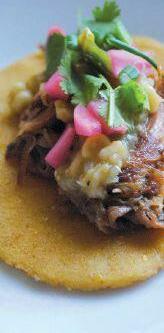
Adapted from Tabitha Stroup, founder and chef, Friend in Cheeses Jam Co. in Soquel

Serves 4, with leftovers
3 pounds pork rump or shoulder with a nice fat cap intact
2 tablespoons coriander, toasted and ground
1 tablespoon chili sea salt
1 lime, juiced
1 to 2 tablespoons pickled jalapeño juice
8 fresh prickly pears or 1 jar of Friend in Cheeses’ Prickly Purple Heart Jam
Combine coriander, chili sea salt, lime juice and jalapeño juice and 2 tablespoons minced garlic and massage into the meat. Marinate overnight or for whatever time you have to wait. en drain excess moisture and pat dry with paper towels. In a Dutch oven, heat a splash of oil and sear all sides to create a nice crust and flavor layer. en place fat side down in the Dutch oven or a slow cooker.
If using raw prickly pears that have not had spines removed, either de-spine them or use gloves to handle, and then cut in half. (Stroup uses a blowtorch to de-spine.) Scoop out the flesh and be sure to strain out the seeds.
Add either the prickly pear flesh or the jar of jam to the pot along with the orange juice, jalapeño, 4 whole garlic cloves and bay leaves. Cook for 3–4 hours, adding more orange juice or some stock if needed, until the roasted meat falls apart. Shred meat with a fork and cook to reduce the liquid and brown the meat.
2 cups orange juice
1 yellow onion, quartered 1 jalapeño
6 garlic cloves, divided 3 bay leaves
Corn tortillas
Salsa verde
Pickled radishes, chopped Green onions, chopped Fresh cilantro, chopped
Serve with the tortillas, salsa verde, pickled radishes, green onions and cilantro.
Note: When in season from August through December, prickly pears can be purchased at Mexican markets with the spines already removed. If harvested wild or from your own plants, be careful of the spines. And always be sure to strain the seeds before using the flesh.
20 edible monterey baysummer 2016
Photo by Camilla M. Mann


www.ediblemontereybay.com 21
PRICKLY PEAR SUMMER
COOLER
Courtesy Tabitha Stroup, founder and chef, Friend in Cheeses Jam Co. in Soquel

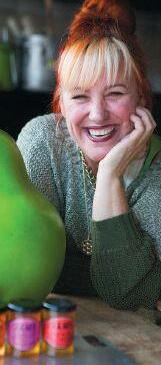
1/3 cup Prickly Purple Heart Jam or cactus pear syrup
Citrus-infused bubble water or splash of tequila and one squeeze of lime
Add jam or cactus pear syrup to a highball glass. Top with citrus-infused bubble water or a splash of tequila and one squeeze of lime.
Cactus Pear Syrup
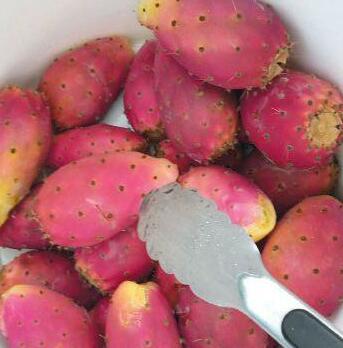
4 medium/large cactus pears (about size of medium avocado)
1 cup simple syrup
1 teaspoon vanilla extract
Sea salt
De-spine cactus pears if necessary (Stroup recommends a blowtorch) or use gloves to handle. Halve and strain pears. Blend with simple syrup, pinch of sea salt and vanilla extract.
22 edible monterey baysummer 2016
Photo of Stroup by Jake omas, prickly pears by Stroup




www.ediblemontereybay.com 23
EDIBLE TRAVEL POSTCARD FROM CUBA

A California chef experiences the island nation’s changing food scene
STORY AND PHOTOGRAPHY
 BY JOHN COX
BY JOHN COX
For most Americans, Cuba is the forbidden fruit of vacation destinations, one of the few countries we are banned from visiting even though its sandy beaches lie merely 100 miles away from Key West, Fla. While it is still illegal for Ame ricans to visit Cuba strictly for tourism, the rules are quickly changing. American investors are waiting for the moment the embargo is lifted and trade can resume with the island. ere is no doubt that when that day comes, so will a flood of international corporations eager to plant their flags in Cuban soil.
restaurants. Private restaurants have always existed to some degree, but at the time of the collapse of the USSR in the early 1990s, it was illegal to officially operate any form of private restaurant. In 1993, when the Cuban government instituted various financial reforms, it became possible for private individuals to run restaurants so long as they followed strict rules on the type of food served, number of seats and people they employed. In 2010, under Raul Castro, many of the restrictions on paladares were lifted, setting the foundation for a restaurant renaissance across Havana.
Imagine a city where anyone can open a restaurant anywhere they want, be it a penthouse on the top floor of an apartment building, an abandoned sugar refinery or a beachfront mansion. ink of it as hundreds of pop-up dinners happening across the city every night. is is the chaos and beauty of Havana’s cu rrent restaurant culture.
On our first night in Havana we went to the Magic Flute, an unmarked jazz club and restaurant in an apartment building by the American Embassy, a block off of the Malecón, a 5-mile esplanade that runs along the ocean. e small room, which couldn’t have seated more than 60, was packed with locals. We had been told that the music and nightlife in Cuba ran notoriously late, so we were surprised to see that the band appeared to be breaking down as we walked in at 11:30pm. As we sat drinking our mojitos and discussing where to go next, we realized that they were just setting up! We stayed for well over an hour before the first set even began. ree hours later, as we left the club, several groups of people continued to sit on the seawall that runs the length of the Malecón, talking, drinking and sometimes dancing in the sea spray.
Earlier this year I decided to throw caution to the wind and visit Havana now, with a group of fellow chefs and sommeliers, before things change too much.
“Panadero!” “Panadero!” e melodic cry echoes through the decaying streets of Old Havana like a pre-dawn call to prayer. A rusted metal cart creaks as it pushes past potholes and piles of debris that have fallen from buildings during the night. Sl owly, doors open and people emerge onto stoops and balconies. An elderly woman on the third floor lowers a cloth bag so the man pushing the cart can drop in a couple of freshly baked rolls.
Cuba isn’t known for its food, but its dining scene is rapidly evolving. First, you need to understand that there are two types of restaurants in Cuba, paladares (privately run restaurants) and state-run
e next few days were a blur. We spent our mornings exploring the streets of Havana, fueled by shots of dark Cuban espresso. We walked the crumbling sidewalks until our feet were sore and our necks were burned by the intense Caribbean sun. When we couldn’t walk any further, we stopped and waited for a taxi. In Havana practically every car on the r oad is for hire, whether or not it displays a sign. We waited until we saw a car that looked interesting and then tried to hail it. e cars, mostly large American sedans from the ’40s and ’50s, ranged from Concours d’Elegance-ready convertibles to taped-together jalopies with springs sticking out from the seats and exhaust billowing in from holes in the floorboards. e drivers often matched the better cars—good-looking Cuban men with short-cropped hair and tightly fitted dress shirts. Frequently they would have a friend or girlfriend
24 edible monterey baysummer 2016








www.ediblemontereybay.com 25






26 edible monterey baysummer 2016
along, seated next to them on the front bench seat, to cruise the town, listen to music and pick up rides.

At night we visited paladares. From the stately Mansion in Vedado that housed Starbien to the sleek, contemporary European design of Otramanera, we made our way through Havana’s newest and most acclaimed restaurants. e venues themselves were stunning, but the menus left me wanting something more. I imagine that the food is not unlike what you might have found in Carmel-by-the-Sea during the 1990s, a melting pot of European flavors with little emphasis on local heritage or ingredients. Sure there was the occasional ropa vieja, a traditional Cuban beef and vegetable stew, but for the most part, restaurants featured a mix of international classics such as Caesar salads, antipastos and paellas. Despite having been warned by a few locals how exorbitantly expensive the paladares were, we found our dinners to be quite reasonable, around $20 per person for food and a couple of drinks.
One night, after visiting a couple of paladares, my friend and I decided to visit the Casa de la Música in Central Havana. It was quarter to midnight and our taxi let us out a block away fr om the entrance. As we walked toward the glowing billboard, a group of women quickly surrounded us, grabbing our arms and pulling us in their direction. ey purred and looked at us from behind rings of dark mascara, making uncouth propositions on how we could spend our night. We quickly put our hands deep in our pockets and fled until we were once again in the dark, quiet streets of Old Havana.
e culinary highlight of our time in Cuba was a trip outside of Havana, to Viñales. is verdant valley bordered by steep rocky cliffs is home to many tobacco plantations and other forms of agriculture. Our first stop was Finca Agroecologica El Paraiso, a working farm and restaurant just outside the town of Viñales. Everything on the restaurant’s menu, from the herbs and vegetables to the chicken and beef, came either from the farm or its neighbors. We were seated on the porch with an incredible view of the valley. e lunch was served family style, a progression of simple dishes showcasing the bounty of the land. It was a perfect meal. From the simple salad and roasted root vegetables to the white bean broth and braised pork, everything was well seasoned and delicious! e freshness and abundance of ingredients were a stark contrast to the seemingly sparse pantries of Old Havana.
After lunch we decided to go on a horseback ride through the valley. Much to our dismay, after negotiating a 2-hour ride, our horses emerged from the stables looking old and gaunt. Our guide, a weathered Cuban cowboy, led us down a steep dirt path toward a secadero, or traditional tobacco-drying barn. As we made our way dow n the treacherous slope. the horse in front of me occasionally lost its footing, sliding a few feet further down the ravine. e lead horse chose the path and picked the pace, with our guide taking up the rear, where he occasionally yelled “Caballoo-OO” while grinding his boots into the side of his horse and pushing the group along its way. When we reached the plantation the farmer was outside and offered us a look at the drying tobacco leaves. Each year, during harvest, a government inspector visits the farm and takes 90% of the leaves for “official” Cuban cigar brands. e remaining 10% are left to the farmer to sell or make into his own cigars. Unlike the large state brands that use nicotine and other chemicals to speed up the processing of the leaves, the farm uses a more
natural method, soaking the leaves with rum, honey and wild guava before fermenting and aging the leaves for up to a year. e resulting cigars are beautiful, with a pleasant aroma and smooth flavor.

As we made our way deeper into the valley, we saw two massive white oxen pulling a plough through chunks of red clay, like a vivid look back in time. Tractors and gasoline are both challenging to find in Cuba, and in recent years the government has promoted the use of oxen on farms. Almost all of the agriculture in Viñales relies solely on people and oxen, with very little pesticides or machinery to contaminate the soil.
We passed freshwater lagoons and papaya orchards. We saw old bristled sows on short chains that dug into their necks, watching their piglets run and splash in the mud. Our guide stopped to pluck a native seedpod used as dye, crushing it between his callused fingers until they glowed orange like tiny traffic cones. We rode our sad and weary steeds until the sun began to set and our guide led us home.
Back in Old Havana my friend and I had become bored with the predictability of the paladares and the large groups of tourists who frequented them. We lucked into meeting a young taxi driver who agreed to give us our change in CUPs (Cuban pesos). Up until that point we had been using CUCs (convertible Cuban pesos), which are commonly used by tourists and wealthy Cubans. e CUCs are worth roughly 25 times mo re than the CUPs.
We took our stack of newly acquired CUPs and hit the streets of Old Havana in search of authentic Cuban food. As we made our way deeper into the city, the streets narrowed and became more decayed. People greeted us, and we responded in broken kitchen Spanish, a dialect that left them confused and prompted them to ask if we were from Paraguay or Argentina. It seems that groups of Americans tend to stay sequestered in designated tourist areas, and the deeper into the city we went, the more exotic we became.
We stopped at a window with a handwritten sign and ordered two Cuban coffees and a torta. e coffee, dark and viscous with a cloyingly sweet finish, was pumped directly out of a tall black air pot into two tiny paper cups. e torta was a state-issued roll with a sheet of egg on top . We paid 15 CUPs and went on our way.
www.ediblemontereybay.com 27
As we walked with our tiny cups of sweet Cuban coffee and half torta, it hit us—we had only paid 60 cents for breakfast! Perhaps this is unsurprising when you consider that the average wage in Cuba is less than $30 per month, but up until that point, we had no concept of the disparity between the two currencies. All of a sudden we realized that we were each carrying the eq uivalent of two years’ salary for the average Cuban. It was a fact that hit us hard, making us think back to the prostitutes outside the Casa de la Música and almost feeling guilty that despite this gross inequality, we could walk through any part of the city like kings, without any concern of being robbed or kidnapped.
e following morning we traversed the crumbling streets and happened upon a thriv ing neighborhood market. I walked in and began taking pictures of local produce. Within a few seconds an old man with a white beard approached me, wagging his right finger in disapproval and motioning for me to put my camera away. I complied and finished the small market loop without taking any pictures. I’m not sure why he didn’t want me taking pictures—perhaps it was to hide the empty shelves, or perhap s it was because of the live chickens and roosters being pulled from their cages.
at night we went to the F.A.C.—Fábrica de Arte Cubana. is sprawling warehouse, which was originally home to Cuba’ electric company and later an olive oil factory, has been converted into a chic nightclub and art venue. Multiple floors display a variety of live entertainment and visual art combined with bars and concession stands. e result is a massive complex that ranges in ambience from rhythm and blues music and contemporary photography to silent films and jazz. By 10pm a large line usually forms outside, and it’s not uncommon for more than 3,000 people to visit on any given night.
By the fifth day the city was beginning to wear on us. e night air in Old Havana was so thick with cigar smoke and diesel fumes that it coated our teeth while we slept. Stray cats came out around midnight, slinking under metal gates and rooting through piles of garbage. A seemingly endless construction project had carved deep scars of excavated sewer lines across the city, leaving treacherous trenches everywhere we looked. Yet despite the general state of decay and seeming lack of resources, everyone we met seemed relatively happy.
One hour of Internet at a local hotel would cost the equivalent of one week’s pay so it’s no wonder that average young Cubans are not going online to check Facebook and see what their friends ate for lunch, or sifting through an inbox of email solicitations or searching for the newest spring fashions.



ere is no doubt that the fog of secrecy is steadily lifting from the island, but for now, Havana’s youths are enjoying more simple entertainment, like cruising the city in their vintage cars, stopping for delicious plates of ropa veija or sweet espresso, and dancing in the mist on the Malecón.

John Cox is the former executive chef at Post Ranch Inn’s Sierra Mar in Big Sur. A prolific contributor to Edible Monterey Bay, he is on sabbatical, traveling, writing, photographing and gathering inspiration for his next project.

28 edible monterey baysummer 2016


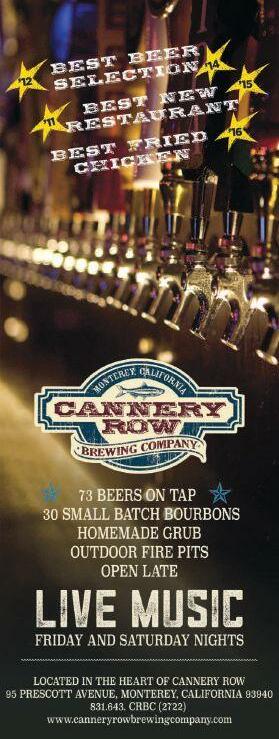
www.ediblemontereybay.com 29



30 edible monterey baysummer 2016
EDIBLE HISTORY
THE MCGRATH HOP
A local heirloom revival story
BY ELIZABETH HODGES
PHOTOGRAPHY
BY MICHELLE MAGDALENA AND MICHAEL SANTAELLA
When I think of South Santa Cruz County and the Pajaro Valley, images of quaint apple orchards dotted with yellow mustard, picturesque vineyards terraced up south-facing hillsides and sprawling fields bursting with perfect rows of strawberries come to mind. But on a recent visit to Corralitos Brewing Co., smack-dab in the middle of said fields, I was surprised to learn that in the late 1800s, hops were actually one of the most prolific crops in the area. Peaking at a time when wheat was on the decline and apples and strawberries were on the rise, Pajaro Valley hops were transported via Freedom Boulevard to San Francisco for shipping around the world.
A man named George McGrath was one of the most successful hop farmers around, growing a unique varietal that was the cream of the crop. But the plant, now referred to as the McGrath hop, all but disappeared when the last hop yard at the McGrath Ranch on Casserly Road was taken out in the early 1950s. Luckily, Luke Taylor of Corralitos Brewing Co. managed to locate some lingering rootstock and revive our local heirloom hop, now part of the Santa Cruz Heritage Food Project, making some tasty beer while he was at it.

A BOTANICAL DISCOVERY

In 2004, Taylor found some hop vines growing while working at a local ranch. He asked about them, and the owner of the property told him that they were the original hops grown on the McGrath Ranch. Taylor later found out that the owner’s great-g randfather had been a good friend of George McGrath. e owner asked if he was a brewer, and upon his eager affirmative gave Taylor permission to dig up some rhizomes. He was amazed at their size—they were as large as his forearm, much larger than the standard hop rhizome, which looks more like a 4- to 5-inch stick.
“I was really excited about how old the variety was,” says Taylor, who naturally took some rhizomes home and started growing them. “Immediately, I noticed a difference in the first flush, which is the initial spring growth when they come out of dormancy.”
Taylor set up a trellis for the McGrath hop, and the variety quickly outcompeted the Cascade, Centennial, Magnum and Chinook hops he was growing. According to Taylor, at the 36th parallel (which is where Santa Cruz is) the other hop varieties just don’t grow as well, as the McGrath hop has adapted over the years to the local climate.
“I knew the hops were something special, and they were responsive to what I was giving them and the local weather,” he says.
www.ediblemontereybay.com 31
Since then, Taylor has spent a lot of time learning the ins and outs of the McGrath hop’s growing habits, learning when to cut it back, when to feed it different nutrients and when to harvest it.
“e hop is magical. It’s unlike any other hop I’ve come across,” says Taylor, noting that its flower exhibits notes of citrus, floral and jasmine with Bartlett pear.
PUTTING IT TO THE TEST
To showcase the special hop’s qualities, Taylor first used it to make a simple Belgian blonde. “I hopped it a little more, similar to an American pale ale and used the Belgian ale yeast to ferment it out,” Taylor says.
Next, he made an American pale ale. Taylor had loved the Belgian, but found the yeast to be a bit too expressive and wanted to work with an American strain of yeast that would really complement the hop’s flavor without overwhelming its subtleties.
Taylor began doing more research on the history of the hop and in 2008 found out that one of his brother’s old school pals, Jeff Bassman, lived on the old McGrath Ranch and his mother’s maiden name was McGrath. So Luke went out to visit and met the whole family, including Jeff’s grandma, Shirley McGrath, and his parents, George and Joan Bassman. And then they went about creating a plan to revive the growth of the McGrath hop together.
is was right around the time that Corralitos Brewing Co. was submitting for its permit application and moving into the Pacific Firewood building, which is zoned for commercial agriculture. So Taylor was already planting hops at the site that would become his brewery and tasting room.
In 2014, Taylor helped return the hop to the original McGrath Ranch, planting 25 hills of McGrath hops together with Jeff Bassman and his father George. Jeff, a butcher at Freedom Meat Locker, now manages the crop.
“I essentially resurrected their family heirloom, and they loved the idea and took off with it,” Taylor says.
Shirley McGrath, now 89, remembers the days when the original hops were grown. She has six great-grandchildren who now live on the ranch, and she thinks it’s a wonderful way for them to grow up. Her husband, now deceased, started working in the hop fields when he was 15. George McGrath was her cousin.
“Of course, it was a big job, but they just grew beautifully,” she says, “I’m happy to see the hops growing again. I think it’s great, and I love to look at them, too.”
e first harvest of McGrath R anch’s newly planted hops in September 2014 yielded roughly 50 pounds of dried hops—just enough for the first large batch of My Girl, which through home brewing experimentation had transformed from an American pale ale to an American rye pale ale.
“I really like the spiciness and almost dry mouth feel that the rye brings to the beer in combination with the qualities of the hop,” Taylor says.
Last year, another 65 hills of McGrath hops were added to the ranch. During the harvest, Taylor threw a hops picking party complete with free beer. (See photos p. 30–31.) He brought his home-brew system and put hops straight into the kettle for a limited-release, wethopped My Girl. irty-five people were in attendance, and this year about 80 will be on site lending a hand.
EXPLORE: e Agricultural History Project Center and Museum in Watsonville offers an exhibit dedicated to the history of hops in the Pajaro Valley. Learn more at www.aghistoryproject.org. To take a hopsgrowing class, contact Luke Taylor at luke@corralitosbrewingco.com.
Elizabeth Hodges is a freelance writer and owner of the Verdant Pantry, based in South Santa Cruz County. During her free time, she enjoys keeping chickens, gardening and connecting with the local food community as communications chair for Slow Food Santa Cruz.
HEADING TO SANTA CRUZ? THE SANTA CRUZ BEER TRAIL PASSPORT IS HERE TO HELP!
e Santa Cruz Beer Trail, co-created by Bryce Root, founder of the small-business marketing firm, e Root Group, and e Brew Cruz tour operator, Annie Pautsch, is here to take your craft beer exploration to the next level.


e Beer Trail’s recently launched Santa Cruz Beer Trail Passport, First Release 2016—our region’s very first be er passport—costs $25 and is full of helpful information for navigating your beer exploration in the northern part of our coverage area.
e passport is also packed with discounts of beer and food. For example, Steel Bonnet Brewing in Scotts Valley is offering passport holders a pint and a bag of chips for $1; Santa Cruz Ale Works is giving 50% off on a tasting flight and three bottles of beer for $10. It’s a big world of beer out there. Grab your passport and go explore! —Rosie Parker
Santa Cruz Beer Trail Passport • SantaCruzBeerTrail.com
32 edible monterey baysummer 2016
CORRALITOS BREWING CO.
Corralitos Brewing Co. draws beer fans to its South Santa Cruz County location from near and far, thanks in part to Taylor’s mad scientist-level barrel program, which started in December of 2014.

According to Taylor, these barrels provide the fifth element to his aging process, a “spice cabinet” so to speak, as the barrels impart various qualities to the beer from the wines aged in them during their prior lives. He also takes advantage of his agricultural surroundings, adding local fruits, such as peaches, apricots, blackberries and raspberries, to select barrels.
“Our beer that has been aging in oak has a very deep, complex Old World flavor going on,” says Taylor. “It might be funky; it might be tart; it might be sour.
“And when you add local fruit, it kind of makes those Old World flavors come to life again. You’re tasting the barrel, the funkiness, and you’re tasting the base beer, which might be dry or soft on your palate, and then you’re getting that fruit-forward finish. It just makes for a much more enjoyable experience.”
In addition to getting set up for bottling these beers soon, Taylor and his business partner Mike Smith have installed an open fermentation room and a large glass window for viewing from the bar area.
“is brings our patrons a little closer to something that’s really fun—it gets them involved with what we’re doing,” Taylor says.
e room is dedicated solely to the barrel program, meaning each beer will see oak barrels, and the space is wall-to-wall unfinished American white oak. e brewery’s goal is to bring in the night air, and with it, wild local yeasts that the brewery will eventually be able to use for spontaneous fermentation.
ere doesn’t seem to be a secretive bone in Taylor’s body; he’s all about sharing his passion for growing hops and brewing beer with others. He teaches a hops growing class every spring that focuses on these wondrous climbers from planting to harvest. e brewery also releases beers under the Roots Brewing Project, an idea Taylor came up with to teach his employees how to craft their own beer with his original home-brewing system. Almost all beers make it onto the board in the taproom. Of note to date have been the Smoked Chile Porter with chiles from Fire Tongue Farm in Hollister; the Oreo Cookie Stout, a Belgian triple with roses and lavender; and the Woodsman, an American pale ale.
So whenever I find the time to slow down and enjoy a refreshing beer or two, I stop by Corralitos Brewing Co. I can never resist trying an Out of the Barrel, a varying selection of single-barrel brews that Taylor found to be standalone specimens.
ere’s just something about the people, the beer and the way that the evening sun glows golden in my glass from across the surrounding fields that feels like home and keeps me going bac k for more.
Corralitos Brewing Co.
2536 Freedom Blvd., Watsonville • www.corralitosbrewingco.com

www.ediblemontereybay.com 33
Luke Taylor at Corralitos Brewing Co.
Hops growing at the brewery Photos
p. 30 and 31, Michael Santaella; this page, Michelle Magdalena
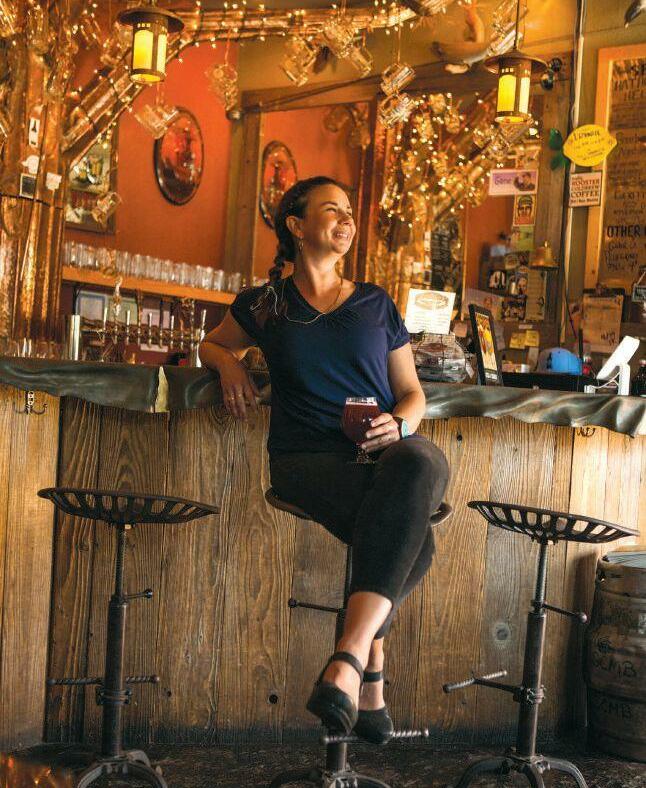
34
edible monterey baysummer 2016
is page, omas in a rare quiet moment at Santa Cruz Mountain Brewing; opposite, with Michelle Ng, SCMB’s events coordinator; Kathleen Genco, co-founder of Discretion Brewing, Taylor Settanni, a brewer at SCMB; and Fran Fitzharris, co-founder of Brewery Twenty Five.
EDIBLE ENTREPRENEUR LEADING LADY
How motorcycle mama Emily omas ignited the Santa Cruz craft beer explosion
BY DEBORAH LUHRMAN PHOTOGRAPHY BY MICHELLE MAGDALENA
e driving force and culinary mastermind behind Santa Cruz Mountain Brewing and e Cremer House restaurant, Emily omas says she often feels like the producer of a Broadway play.

“Every morning I go in and I have this cast of characters and all the sets and the props. It’s high drama. Everybody’s got their stuff going on, equipment is breaking,” she says. “It’s really intense and then somehow, miraculously, we open and it’s like a beautiful show.”
omas, who at 41 runs two successful businesses and manages 60 employees, likes to spend mornings at the brewery and then hop on her black Triumph Bonneville SE for the 10-minute ride through the redwoods up to the restaurant in Felton.
“Riding that motorcycle and yoga are my meditation,” she says. “It gives my head a chance to disengage.”
is summer she has even more than usual on her mind with the brewery’s first major expansion. SCMB is tripling its floor space, adding a 2,400-square-foot suite adjacent to the current brewery.
Part of the new space is being used for an 800-square-foot walkin cooler, and the rest is filled with fermentation tanks of various sizes—which will allow SCMB to brew three times more beer than it does now.
“We just couldn’t make enough beer,” omas explains. “People wanted a kind of community center with the beer garden and taproom, so we put a lot of energy and effort into creating that, but once we did, all of our beer was being consume d there.”
e expansion will also enable the brewery to have a bigger presence in local shops and restaurants and pursue exciting new projects.
For example, SCMB will begin selling its brews at the Westside Santa Cruz and Felton farmers’ markets this summer. anks to a new state law, shoppers will be able to sample beer at the farmers’ markets and take home bottles, 12-ounce cans and “crowlers”—32-ounce cans filled at the brewery.
SCMB is also expanding production of the beer it brews each summer for the Santa Cruz Beach Boardwalk. is year, instead of one special beer, it will make four brews using recipes from the past four seasons: Giant DIPA, Boardwalk Blonde, Horse Tale Ale and Casinos IPA.
In the second year of its collaboration, SCMB won the Brass Ring Award for “Best New Innovation in Food and Beverage” at amusement parks worldwide, a prize handed out by the International Association of Amusement Parks and Attractions. A new mobile canning service
www.ediblemontereybay.com 35
this year will help SCMB get cans of the four beers out to more Boardwalk concessions and local shops.
If her brewery can make enough, omas wants to expand distribution to the South Bay, then maybe San Francisco and Oakland, but no farther.
“When we first started we did the whole West Coast and Hawaii and we felt that the farther the beer got away from us, the less we could control the quality,” she says. “With the availability of good local craft beer in pretty much every city, I don’t think it is necessary to go farther than your local area.”
LOCAL ROOTS
e eldest of four siblings, omas grew up in the San Lorenzo Valley on the grounds of a conference center in Ben Lomond, where her parents were caretakers and her mother was the cook. All of the food was vegetarian and mostly organic. So tinkering in the kitchen comes naturally.
“Moosewood and Mollie Katzen were our go-to resources. I’ve probably made every dish in the first three Moosewood cookbooks,” she says with a laugh. “My parents definitely loved food.”
While attending Lewis & Clark College in Portland, Oregon, omas developed a taste for craft beer and learned the art of brewing from her uncles, who lived locally and had a great appreciation for Portland’s microbreweries.
ough she graduated with a degree in journalism, she took a job in San Diego, another craft beer capital, as a secretary working for tech giant Qualcomm. She caught on so quickly that within six months she was promoted to engineer.
After 10 years in the corporate world, omas returned home with the idea of bringing the flourishing craft beer scenes of Portland and San Diego to Santa Cruz. In 2005, she and former husband Chad Brill founded Santa Cruz Mountain Brewing, igniting the current boom. omas and Brill have two school-aged boys and still happily share both child rearing and running the brewery.
“I came back and couldn’t figure out why there were only Seabright and Boulder Creek brewing,” she says. “I’ve always wanted Santa Cruz t o be a beer destination.”
Now with 15 craft breweries in Santa Cruz County alone and dozens oftap houses in the area, omas shines as the leading lady of the brewing community. “We really work hard to be united. We’re only 6% or 7% of the entire beer market,” says omas of the position of craft brewers nationally, “so our true competition is the big beer companies, and we kind of all stick together.
“People who get into brewing are passionate about what they do, and we all try to do something unique so it is less threatening to each other and makes everyone friendlier,” she adds. SCMB remains the area’s only certified organic brewery, although other breweries make some organic beers.
Surprisingly, she believes there’s still room for more local breweries. “A brewpub is different from a coffee shop, it’s different from a bar, it’s different from a restaurant,” she says. “It’s more casual. You can meet friends there after work or hang out with your dog, so I really think every part of town could sustain a beer bar or brewpub, for sure.”
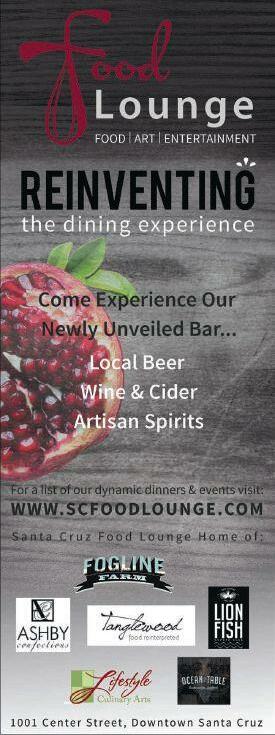
36 edible monterey baysummer 2016




www.ediblemontereybay.com 37
BEER+FOOD
DrivenbyherloveofcookinganddesiretoopenabusinessintheSan Lorenzo Valley where she grew up, omas opened e Cremer House restaurant and alehouse in late 2014. It’s located in an allegedly haunted former hotel, boarding house, tavern and brothel built in 1874.
Together with building owner Bob Locatelli, who also owns the New Leaf Community Markets store next door, she spent months painstakingly restoring the property with vintage finds and rustic handhewn touches. A copper kettle with 25 taps was installed behind the bar, where omas gets to offer not just SCMB’s beer, like the brewery’s own location in downtown Santa Cruz, but also favorite craft beers from other breweries that omas has discovered in her travels around the country. She also created most of the opening menu herself—focusing on all-American comfort foods and vegetarian options made with fresh, seasonal, mostly organic local ingredients.
“We do all our buying with New Leaf,” she says. “Bert Brown has been doing their produce buying for 30 years and he knows every farm in the county.”
As for sticking with organic ingredients: “It’s always been important to me,” says omas. “It doesn’t necessarily have a lot of commercial draw in terms of what the cost of it is, but that’s the way I was raised. It’s just an ethical choice.”
roughout the summer, e Cremer House is hosting a series of Tuesday night farm dinners to coincide with the Felton farmers’ market. Using produce from a different local farm each week, chef J.P. Doiron will create a special farmers’ market menu that will be availab le alongside the regular dishes.
For the brewery and for the restaurant, to a lesser extent, omas relies on three types of customers. “You get your locals, but it’s very expensive to live here so they might not be willing to spend as much on a regular basis; then you get your tourists, but that season fluctuates with the weather; and then the other customers are UCSC students,” she says. “I like to have a trifecta of customers.”
Business is brisk, but omas says she’s learned a lot about the hospitality business over the past few years. “I’ve always wondered why there aren’t more restaurants in Santa Cruz, but I know now from my own personal experience that it is not an easy place to do business,” she says.
“It’s really hard to get the city and the county on board with new business plans. ey are always excited about it, but it’s way easier in Portland to start a new business, get zoned for it and build it,” she says.
“It’s so restrictive and it’s expensive. at’s why people go towards pop-ups and food trucks and take the catering path, so they don’t have to invest in bricks and mortar,” she adds. “In the end, I think Santa Cruz would benefit from more established places.”
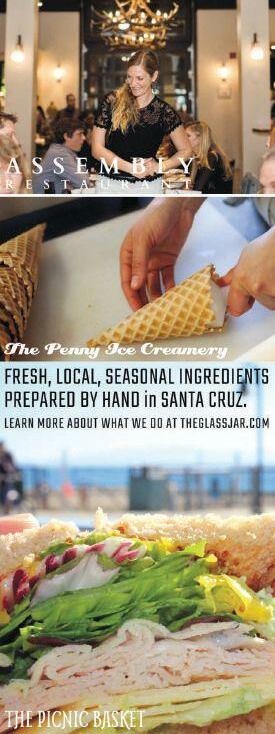
KEEPING IT FRESH
To keep everything fun and exciting, dishes are rotated according to the seasons. e wintry chicken pot pie, for instance, was recently replaced by lighter Arctic char, with spiced couscous and yogurt dill sauce. But favorites remain, such as the puffy house-baked pretzels, fried chicken with maple-mustard coleslaw and the Cremer burger. e restaurant’s vibrant and creatively spiced pickled vegetables and condiments are house made and available for sale to take home.
38 edible monterey baysummer 2016
At the brewery, head brewer Tommy Mills—who just returned from a 2-year stint at NOLA Brewing Co. in New Orleans—was experimenting with a batch of horchata pale ale the day we were there.
“Because the tanks aren’t huge and we have a lot of them, we can keep being creative with what we do,” says omas. “We have our six flagships, but one of the ways we keep ourselves inspired is to let people brew what they want.”
omas also hosts one of the wackiest and most creative beer fests around, the Twisted Tasting. Held every winter during San Francisco Beer Week, it was inspired by a visit to the Great American Beer Festival where omas sampled a pig’s head porter made by a Michigan brewery called Right Brain.
Twisted Tasting includes all of the local craft breweries and offers brewers a chance to dress up in fanciful costumes and be as weird and wild as they want. Last time one of her personal favorites was a currylaced ai Coconut Stout from Brewery Twenty Five in Hollister. And the first year, SCMB created a version of the pig’s head porter using pig’s ears smoked by el Salchichero butcher Chris LaVeque.
“ey imparted a smoky richness,” she recalls. “It was pretty good.”

omas also organizes the popular SausageFest every fall on the first weekend that UCSC students are back in town. Some 2,000 people descend on a Westside field to sample sausages and drink craft beer.
“It’s one of those days when we get to have fun and make fun of ourselves. We have all the other breweries there, so it’s a great way to introduce those students to what’s happening in town,” she says.
is year SCMB is partnering with the Land Trust of Santa Cruz County on the event, and it is also releasing a special beer for the Land Trust in September called Rail Trail Ale. Profits from the beer—which will be available in stores and at the brewery—will help finance a 32mile paved bike trail from Davenport to Watsonville.
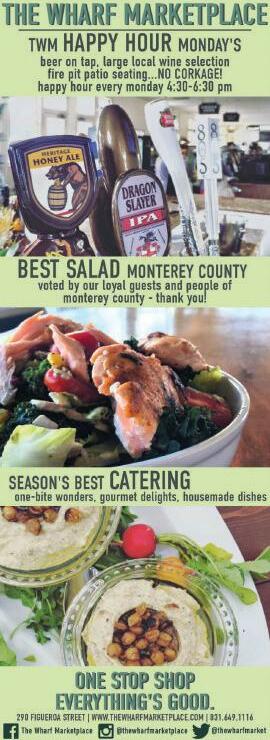
Being among the first women in the country to brew beer and own a craft brewery has not always been easy, she admits, and that’s one reason omas started offering special educational events such as the annual Strong Women Brew Strong Beer, a homebrew class for women.
“Eleven years ago when we started, beer was a guy’s drink and women drank wine,” she says. “We could see that was changing and just wanted to give it a little push.”
Nowadays she sees a huge movement of young women who want to be part of the beer culture. In just the past decade the number of women brewers at the national Craft Brewers Conference has grown from 12 the first time omas attended to more than 600 the last time she went. “ere are definitely some challenges, but little by little we are having our voices heard,” she says.
As for the future, omas hopes to spend at least a month this summer in the Pacific Northwest, visiting breweries and doing some collaboration beers. She is eyeing properties in historic downtown San Juan Bautista and feels “a very strong desire to do business there.”
So for this producer the show’s not over yet. Pay close attention to find out what happens in the next act.
RECIPE: See p. 41 for omas’ Smoked Black Cod Panuchos.
www.ediblemontereybay.com 39

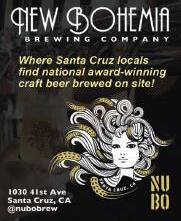

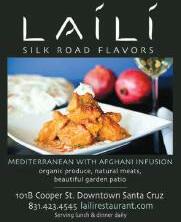



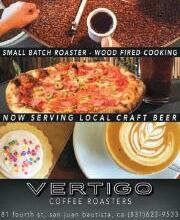
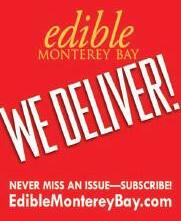
40 edible monterey baysummer 2016 MONTEREYBAYMARKETPLACE•MONTEREYBAYMARKETPLACE
SMOKED BLACK COD PANUCHOS AND BEER-SOAKED WATERMELON
 Courtesy Emily omas, proprietor, e Cremer House in Felton
Courtesy Emily omas, proprietor, e Cremer House in Felton

My grandmother was the secretary to the U.S. ambassador in several Latin countries and I was fortunate to travel with her throughout Central America, where I developed a love of Latin cooking. Panuchos are one of my favorite Yucatan street foods. Typically a late night snack made with shredded chicken or turkey, I love the depth that smoked black cod brings to them. ey go great with beer.
2½ cups dried masa
1 teaspoon salt
1 cup boiling water
1 cup beer (I like a pilsner)
Smashed or refried beans
Smoked black cod (I love the one from Real Good Fish)
Cabbage slaw (finely chopped cabbage, cilantro and lime juice)
Pickled red onions (make from finely sliced red onion, white or pineapple vine gar and salt)
Additional toppings: sliced avocadoes, sliced tomatoes, finely crumbled cotija cheese, pickled jalapeños, habanero hot sauce and lime wedges
To make masa dough, mix first four ingredients thoroughly. e dough should be firm and springy, not dry or sticky. Let it rest for an hour, covered. Roll into 12 small balls and keep covered with plastic.
To make panuchos, flatten a ball by hand or use a tortilla press. Place on a hot, oiled griddle. Put 2 tablespoons of beans on the tortilla. Cover with another flattened masa ball. Press down with a spatula and cook until the bottom is browned. Flip and repeat. Remove from griddle and top with the cod and other toppings.
Beer-Soaked Watermelon
Watermelon, cubed Feta cheese, sliced Cilantro leaves Jalapeño, thinly sliced Gose (like Otra Vez)
Arrange cub es on a platter and gently drizzle with Gose. Place a cilantro leaf, slice of feta and jalapeño on top to make a stack.
www.ediblemontereybay.com 41
SUMMER FORAGING
KAYAK FISHING

A day on the water hooks our writer
BY ROSIE PARKER PHOTOGRAPHY BY PATRICE WARD
42 edible monterey baysummer 2016
Doc H and the author on the water near Del Monte Beach
e sun is just coming up over Monterey Bay as we launch our kayaks into the placid waters lapping Del Monte Beach. e air is already warm and the calm morning seems to promise a hot and clear-sky day.
My guides for the day are David Haan, a graduate student at UCSC, and his fishing partner, Kristof Tigyi, and they have agreed to initiate me into special rites, safety precautions and addictive pleasures of kayak fishing. Haan and Tigyi, to whom I will refer by their VHF radio names, Doc H and Kritter, respectively, are a committed duo who are out on the early morning waters whenever time and conditions allow for it. ey both grew up fishing on lakes, ponds and rivers (Doc H is from Chicago and Kritter, Memphis). After transplanting themselves to the West Coast, they decided that kayak fishing was the most affordable way to experience their next fishing adventures.
Indeed, part of the beauty of a kayak is that it can take you far (sometimes for salmon fishing, six miles offshore), but you don’t have to deal with the storage and maintenance, much less the purchase cost, of a typical ocean-worthy boat: A basic sit-on-top kayak and a sonar/depth finder/GPS combo, a VHS radio and fishing gear can be had for about $1,500 (See Tips for Kayak Fishing on p. 45 for more on getting outfitted.)

When I ask about their favorite places to go, Kritter reminds me that a fisherman doesn’t kiss and tell and that much information h as to be guarded. Part of the experience is searching out spots and flagging them with their GPS for the future. Generally speaking, however, Monterey and Santa Cruz are good for rockfish and lingcod, while halibut can be found in Santa Cruz or Moss Landing, they say.
Doc H and Kritter usually know what they want to fish for, and that dictates their strategy. Rockfish and lingcod are the easiest to come by, so when they want to make sure they’re catching dinner that day, they head to Monterey’s relatively uncrowded waters and fish the rock outcrops, hoping to catch their limit. For halibut or salmon, they have to be more intentional, planning their day around fishing only for the one species (and often come up empty handed).
Today, we’re hoping for as many bites as possible, so we’re trolling for rockfish and
lingcod using fresh anchovies and frozen squid for bait. Doc H and Kritter have places marked on their GPS that they like to go, like Halibut Hotel and Ling City (their names), but they’re happy to paddle around to see what else they can find. Looking out for rocks with the sonar, we move through the water, waiting for the first bite.
WHAT TO EXPECT
How the weight feels on your line can be an indication of what you are about to bring up. Rockfish will feel like a constant tugging— sometimes strong, but often just a hefty nibble, while cabezon are akin to picking up a rock from the bottom of the ocean. Lingcod are a different kind of fighter. ey run a lot, pulling out your line, so it’s best to let them tire out. A snag of seaweed just feels lifeless.
One of the biggest challenges is properly securing your fish after it has surfaced. Your method will depend on size, weight and species. California halibut go crazy once pulled out of the water and need to immediately be knocked out by what Doc H and Kritter call their headache stick (not an official term). A larger fish might require a gaff— a pole with a sharp hook at the end of it. If the fish has some gnarly teeth, use a lip grip to hold the mouth open. It’s best to slit the gills and let the fish bleed out as you bag them up. is will improve the quality of the meat.
Truthfully, you can’t be certain about what you’re going to reel in. at’s half the fun. Just be prepared for anything.
CATCH OF THE DAY
About 45 minutes on the water, a mile offshore, and at a 40-foot depth, I feel my first strong tug. Doc H has something as well and we each reel in a rockfish. At the same time, Kritter, 500 yards away and at a depth of 65 feet, has something big pulling on his line. He calls for backup, and we hurry over to watch him haul in a beautiful, blue-mouthed cabezon (about 20 inches long and 5 pounds). Only a couple minutes later, Patrice, our photographer, who is trolling while he snaps some shots of proud Kritter and his catch, has clearly hook ed something huge. With a look of utter excitement, Patrice pulls in a 26-inch-long, 6-pound lingcod. ere’s a brief pause, and then Kritter catches his second cabezon. Feeling amazed at our 5-minute
www.ediblemontereybay.com 43
bounty, Doc H points out that it sometimes depends more on the moment (or luck) than the location.
is point is made clear when we hit a lull, trolling for two hours and getting nothing but nibbles and seaweed snags. Of course, between the warm sunshine, the crash of the surf echoing in the bay, and sea otters and gray whales swimming all around us, this can be the most relished time on the water.
Full d isclosure: Relaxing with the gentle rocking of the kayak is also a good time to succumb to your motion sickness. And it is in this moment of serenity that I start “chumming” the waters.
I would be embarrassed, except that the fishing gods clearly like my offering because shortly after, I reel in a double catch of rockfish.
Everyone’s luck picks back up and in the next several minutes we catch about 10 more r ockfish, tossing back a few of the smaller ones. e varieties of rockfish coming up include blue, black and China. All are roughly 14 inches in length.
e first round of big fish was the triumph of the day. But this last burst of action, as Kritter points out, this is dinner. Satisfied, we head back to shore.
FEAST OF FISHES
What do you do with a cooler full of fish? Invite all your friends over for a barbecue!
Out on the water, depending on their luck with the day, Doc H and Kritter start planning that evening’s festivities by sending out invites from their phones to as many people as they can reasonably feed, a practice they started from the beginning of their fishing days together, because they feel it’s important to share the love with their community. And because they’re out on the water almost every weekend, there tends to be a lot of love to go around.
Of course, there are a few steps between reeling in a rockfish a nd enjoying it battered and fried in a taco.
Back at home, Doc H and Kritter unload the car, rinse the saltwater off all their equipment and process that day’s bounty.
Not quick or easy, cleaning and filleting a fish is an art that requires practice and patience.
By the early evening, there are about 15 people at Doc H’s house that he shares with five other UCSC grad students (many of whom go spearfishing as their foraging sport of choice, if you’re in need of options). e scene is lively yet relaxed with friends scattered about—helping in the kitchen, lounging on sofas or enjoying beers outside.
e catch of the day dictates the menu. Rockfish tend to be fried or grilled for tacos, served with homemade slaw and pico de gallo. Cabezon and lingcod—firm, flaky and mild—are great for poaching. On this occasion, Kritter turns the cabezon into ceviche, while a friend poaches the lingcod and serves it with a delicate beurre blanc sauce.
From daybreak to dusk, it’s been a long day. But to wake with the sun and paddle out to sea; to catch, clean and cook your own fish; to be able to feed your community—it’s a deeply gratifying experience. See you on the water.
EXPLORE: To be safe and learn more, see TIPS FOR KAYAK FISHING, opposite.


44 edible monterey baysummer 2016
Doc H and Kritter getting their kayaks ready just after dawn at Del Monte Beach in Monterey
TIPSFORKAYAKFISHING

GETAFISHINGLICENSE. One-day($15.12),two-day($23.50)andannual($47.91)fishinglicensescanbepurchasedat www.wildlife.ca.gov/licensing.
KNOW THE RULES AND REGULATIONS. ere are size and number of catch regulations that must be followed as well as set dates for each species’ fishing season. Game wardens can and will check your haul. And remember: Don’t fish in protected waters! A complete list of the official Ocean Sport Fishing Regulations with up-to-date information can be found on the California Department of Fish and Wildlife site: www.wildlife.ca.gov/Fishing/Ocean/Regulations/Fishing-Map/Central.
CHECK THE WEATHER. Learn to read tide charts and swell and weather reports. DO NOT go out on the ocean to fish in bad swells, big waves or winds over 15 mph. Check the radar all the way up until la unch.
SAFETY FIRST. You are required to wear a life vest at all times. Bring a waterproof VHF radio to contact the Coast Guard in case of an emergency.
DRESS APPROPRIATELY. You might start at daybreak, but that sun gets strong while you’re out there. Bring a hat, sunglasses and sunscreen. Wear a wetsuit or other waterproof clothing. Surf booties are a must.
BE PREPARED. You can easily be on the water for five to six hours or longer should anything go wrong. e ocean will tire and dry you out. Bring plenty of water and snacks.
e author with a rockfish
AVOID SEASICKNESS. If you are prone to motion sickness, then make sure to use a nausea patch or take some Dramamine 30 minutes before you get in the water. Just remember that anti-nausea medication can make you drowsy.
RESPECT THE MARINE MAMMALS. ere is a hefty fine (up to $11,000) for touching or feeding any of the amazing marine mammals you see on the water. (And sea otters will bite.) Respect their space.
GO EARLY. Around sunrise is best for the biting, and since the winds tend to pick up in the afternoon, you have a better chance of calm seas in the morning.
CHOOSE YOUR BAIT. Buy frozen squid from the grocery store or catch live bait (anchovies, mackerel) while out on the water. Live bait is best, and the bigger the bait, the bigger the fish.
CONSULT THE EXPERTS. ere are lots of great online resources and forums like www.norcalkayakanglers.com or www.centralcoastkayakfishing.com. If you prefer to talk with someone in person, visit your local fishing store where you can pick up a current list of rules and regulations and ask for tips and help. Once you’re out on the water, make friends with fellow kayak fishers. Channel 69 on the VHF is for kayakers.
BE PATIENT. It’s normal to come up empty handed. Fish are smart and a challenging opponent, especially when you’re on a kayak. Just remember that this is a pastime, not a hunt.
www.ediblemontereybay.com 45
THEPRESERVATIONIST ADD SOME FLAVOR TO YOUR JAMS!

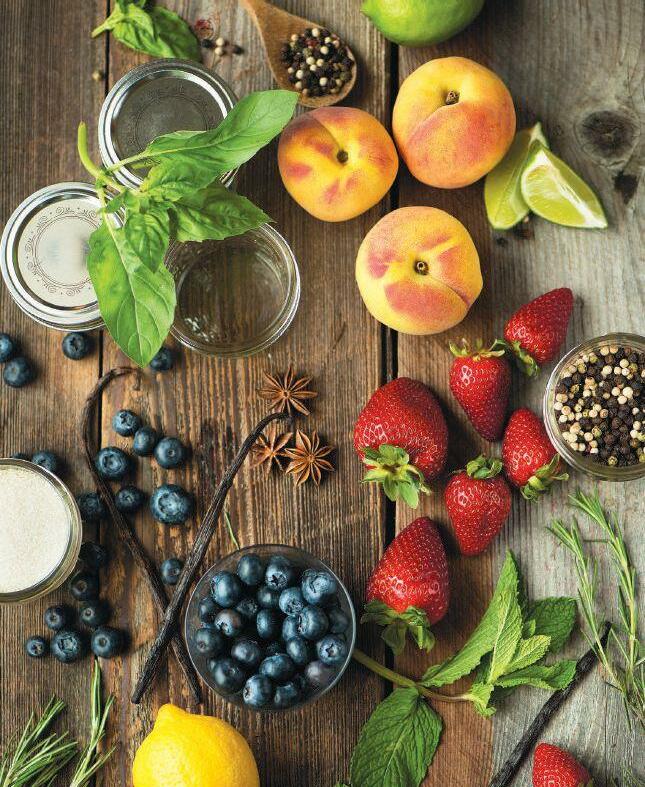
Okay, you know the basics. Now, let’s up your game
BY JORDAN CHAMPAGNE PHOTOGRAPHY BY ANGELA AURELIO
46 edible monterey baysummer 2016
ere is something special about making your own jam. You get the chance to preserve local fruit, and much more than that, you can also preserve memories and create new relationships with people around you, such as those you buy your fruit from or give your finished product to. It also allows you more control over the ingredients in the jam you eat, as you can select high-quality fruits and decide what kind and how much sugar to use. I sing the glories of preserving your own food in every article I write for Edible Monterey Bay; now, I would like to introduce a concept that will take your preserving to the next level.

Once you have down the fundamentals of making jam, it is time to experiment. One of the most rewarding ways to do this is by adding herbs and spices to your jams. ese flavorings will add layers of complexity that will make your preserves stand out—and even become completely unique. Adding spices can also be a wonderful way to clear your cabinet of all those seasonings you never got around to using.
One time when I was teaching a jam workshop at a mommy retreat in Big Sur, I discovered a new combination completely by accident.
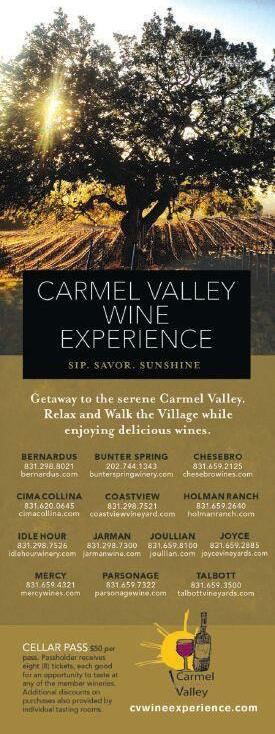
While my class was cooking down a raspberry jam, another instructor took a group out to the garden to harvest some herbs to make an “herbs de Big Sur sea salt.” He came inside just as we were doing our first plate test on the jam, and I asked him to try it. He tasted the jam and said, “Wow, raspberry thyme jam. I never would have thought of that, but it is delicious!”
We hadn’t put any thyme in the jam, but he had just harvested a bunch of thyme and still had thyme oil on his fingers when he tasted the jam. Raspberry thyme jam is still one of my favorite flavors to this day. (See recipe in our Spring 2013 issue or at www.ediblemontereybay.com/recipes.)
When you add herbs and spices to your jams, they start to claim more places in your culinary life. Raspberry thyme jam can be wonderful on toast, but it also does wonders on a cheese plate, or on a bagel with cream cheese, or in a dressing or a special sauce.
When you’re ready to start experimenting with making new jam flavors, I recommend taking a little of your jam aside during the cooking process and trying the flavor on a small amount. It is always better to err on the side of caution in these instances. e flavors should be subtle and help accentuate the fruit—not overpower it. Add a little, taste and then add a little more. Also remember that flavors usually concentrate over time.
Best of all is to have fun with it. e possible flavor combinations are truly endless, and you do not have to spice up the entire batch of jam either.
Here are some ideas so that you can see what I am talking about: Ginger is one of those spices that seems to go with everything, so it can be a good place to start. Strawberry goes really well with lavender, basil, cracked black pepper or rosemary. ere is so much one can do with apricots. Here at Happy Girl we added Nuevo Mexico chiles for a smoky undertone and won a Good Food Award for it. You can also try garam masala, cardamom or cinnamon. Peach goes great with vanilla, rose or star anise. Blueberries are a classic with mint. (See recipe p. 48.) Would you like to try some of my blackberry lime cracked pepper jam?
Jordan Champagne is the co-owner and founder of Happy Girl Kitchen Co. She has a passion for preserving the local, organic harvest and loves sharing her secrets at the workshops she teaches across the region.
www.ediblemontereybay.com 47
BLUEBERRY MINT JAM
Courtesy Jordan Champagne, chef, instructor and co-founder, Happy Girl Kitchen Co. in Pacific Grove

Yield: 12 4-ounce jars
Many people have great memories of going blueberry picking in the Northeast. One of my favorite children’s books is Blueberries for Sal by Robert McCloskey, in which a mother and child head out to the bush for a day of blueberry picking and have quite the adventure before returning home to make jam. Blueberries are tiny and make a wonderful sound as the fall into a bucket. It takes a lot of work to harvest enough of any small berry to make jam, but it is a lovely way to spend the day.
Here on California’s Central Coast, it used to be that even cultivated local blueberries were uncommon. But it seems that we can figure out how to grow everything in California, and with the help of hybridists and soil scientists, we are now one of the largest producers of blueberries in the United States. So today we are able to make jam out of local blueberries, too!
4 pints blueberries
¼ cup lemon or lime juice
1½ cups organic sugar

1/3 cup fresh mint leaves, finely chopped ¼ cup lime zest
Wash, dry and place your blueberries in the pot you will be cooking them in. Cover the blueberries with lemon or lime juice and then with sugar. Even though blueberries have a tough outer skin, I still let them macerate overnight with the juice and sugar. is can help decrease the cooking time the next day. If you do not have the time to wait, then you can skip this step with blueberries.
e next day you can begin to cook your jam on a medium to high heat. e contents should boil the entire time. Add lime zest 5 minutes into cooking and continue to boil. Boil contents until gelling point is reached (10–15 minutes). Add mint leaves just at the end. Fill jars and process in a hot water bath canner.
48 edible monterey baysummer 2016



www.ediblemontereybay.com 49

ON THE FARM
DEERHAVEN LAVENDER FARM

A family finds harmony with the land through lavender
BY PATRICE VECCHIONE PHOTOGRAPHY BY MICHELLE MAGDALENA
When she smelled fire one hot June day eight years ago, lavender grower Mary Nulph Jessen became suspicious and went outside. It was clearly not a chimney fire she was getting a whiff of—the season was too warm for that. e wind was coming from the northeast, not as it usually does, off the ocean a few miles to the west. Mary looked up at the sky, saw a big plume of smoke and knew it meant trouble. She grabbed her three dogs and two cats and got them safely in her car. By the time she drove out her driveway less than an hour later, flames had reached her property and were nearly licking the bottom of her car. Quickly, helicopters had begun dropping fire retardant.
Mary and her husband, David, live in a 10-acre meadow, a wide bowl of earth that’s surrounded by the forested Bonny Doon Ecological Reserve. A farm for more than 100
years, it’s been a pear and a plum orchard as well as a Prohibition-era vineyard. Part of this quiet green sanctuary was once almost lost to a golf course as well as to fire, and it is only a couple of miles away from Highway 1. But it feels miles and miles away from the pace of city life. It’s here that Mary grows lavender. Lots of lavender.
e property is filled with big fields of the clustering pale green bushes with uplifted stalks and purple heads. Brush against the lavender as you walk by or bend down to rub it between your fingers, and the sweet, pungent scent fills the air and stays with you for a long time.
Mary and David started their lavender growing in the early 1990s just for pleasure, with about 30 ornamental lavender plants. ey’d just recently bought the property from e Nature Conservancy after the nonprofit

acquired the surrounding area for preservation. e Jessens had already rented it for more than 10 years and Mary had grown tired of watching the deer eat pretty much everything but the lavender, including her beloved roses.
“Lavender is the only thing they wouldn’t eat,” Mary says, and she figured she could work with that.
By 2004, she and David recognized a business opportunity that would fit their family’s lifestyle.
Mary and David had both been raised in Bonny Doon and loved the rural life.
“I grew up learning from the area’s Italian wine growers what we now call organic, biodynamic growing practices, following nature’s rhythm, in tune with the seasons,” David says. “ose growers did everything by hand, as we do.”
www.ediblemontereybay.com 51
“I grew up outdoors,” Mary says, “is is what I know.”
Lavender is also not hard to cultivate.
“Lavender is one of the easiest things to grow—it’ll even grow in very rocky soil. at’s why I can grow it,” Mary says with a laugh. Its requirements are simple: sun, sandy or other well-draining soil and barely any fertilizer.
Deerhaven Herb and Flower Farm began small, with about 1,500 lavender plants.
At first Mary took her bouquets down the hill to Fambrini Farms at Highway 1 between the months of May and October. Soon she extended her reach to New Leaf Community Markets, the Bonny Doon Garden Co. and a few Bay Area florists. Her lavender products, which include handcrafted soaps, essential oil, gardener’s salve and sachets are now also carried by such stores as Mountain Feed & Farm Supply, Flower Outlet and Shopper’s Corner.
Mary also shares her expertise with the community, offering, for example, training in


the production of soap and salves to the Homeless Garden Project.
Summer is the height of lavender season, and June is when the lavender varietal called Grosso, the type that Mary was growing at the time of the fire, begins to come into its own. It gets harvested in early July. But as Mary left her home that summer day of the fire in 2008, her purple, budding crop was the last thing on her mind—she couldn’t think about her hard work literally going up in flames.
With the fire rapidly encroaching on their property, a fire crew determined it was a goner and decided to put its efforts elsewhere. However, they’d not taken David into account. He’d stayed on to defend the farm and could be seen from a helicopter above, one lone man on a tractor.
Undeterred, David moved mound after mound of dirt, using it to serve as a firebreak to protect his and Mary’s home and outbuildings. By this time, two 5,000-gallon water tanks had melted and the power was out. Seeing David’s determination, the fire crew returned to help, filling garbage can after garbage can with water from the Jessens’ swimming pool to help put out the flames.
Despite their efforts, one house on the compound and Mary’s soap shop burned to the ground. In total. t hey lost four buildings and most of Mary’s nearly harvestable lavender plants.
On a recent visit, the marks of the fire were still apparent—there are many charred tree trunks still standing. A meadow that was once scattered with trees is now nearly entirely open, as not only did the fire destroy many trees, but afterwards, a number of stressed but surviving pines were killed off by pine bark beetles. e remaining snags look ghostly, just the husks of trees. But since nature is ever resourceful and appalled by waste, those unbeautiful trees have been transformed into ideal nesting places for acorn woodpeckers and red-tailed hawks.
“After the fire,” Mary says, “we took a step back and realized we could grow much more lavender.” e forced clearing allowed her to double the size of her lavender fields, and she now grows about 3,000 plants. e loss of so much also gave her the impetus to try new varieties, leading her eventually to
what she refers to as “the most scented lavender,” Violet Intrigue.
Inhale the best-known lavender, Grosso, and you breathe in that familiar, heady, camphoraceous lavender scent. Violet Intrigue, on the other hand, is sweeter, less pungent and far more delicate. For her essential oils, Mary blends the two varieties through a process of steam distillation. e byproduct of the distilling process is what she uses to create floral water. But for her handmade soap, Grosso is her choice.
For the culinary lavender that Mary uses to make lavender sugar, she says Violet Intrigue buds are the best. She also grows a bit of Maillette lavender for this purpose.
“Lavender sugar is delicious in shortbread and scones,” Mary says, and this visitor can attest to that. e shortbread is sweet and buttery with a hint of lavender, making what is normally a plain cookie anything but.
e fire might well have destroyed the Jessens’ lavender farm forever. But today, both the farm and the deer are thriving, and for that, Mary is grateful.
From the window of her rebuilt soap shop Mary watches deer graze
“When I’m wrapping soap, the deer are peeking in. I’m reminded daily how lucky I am that my workshop is here.”
Monterey artist and writer Patrice Vecchione’s latest book is Step into Nature: Nurturing Imagination and Spirit in Everyday Life. For more, go to www.patricevecchione.com.
Deerhaven Herb and Flower Farm 854 Martin Road, Santa Cruz 831.427.1919 • www.deerhavensoaps.com
EXPLORE: Deerhaven Farm is open to the public for U-pick lavender on weekends throughout June and July.
RECIPES: Please see www.ediblemonterey bay.com/recipes for three lavender recipes from Ellie Lavender, proprietor of Lavender Design + Cuisine in Santa Cruz: Moroccan Couscous Salad with Lavender Lemon Tahini Dressing, Strawberry Lavender Tart and Lavender Lemon Vinaigrette.
52 edible monterey baysummer 2016


www.ediblemontereybay.com 53

Dine Local GUIDE

Pt. Pinos Grill not only serves fresh, sustainable ingredient-driven meals for breakfast, lunch, happy hour and dinner; its kitchen is also the staging ground for all sorts of special events overseen by executive chef Dory Ford and his renowned Aqua Terra Culinary catering company.
APTOS
Carried Away

7564 Soquel Drive • 831.685.3926
www.carriedawayfoods.com
A cozy, green-certified, take-out or eat-in café, Carried Away has a menu that changes weekly and features primarily organic, locally sourced ingredients. Owner/chef Tom McNary worked for many years at Chez Panisse, and his dishes reflect the seasons. Soups, salads, entrées and desserts are all made freshly daily. in-crust pizzas available on Tuesday, Friday and Saturday. Open M–F 11am–7pm, Sa 11am–5pm, Su closed.
BIG SUR
Sierra Mar at Post Ranch Inn
47900 Highway 1 • 831.667.2800
www.postranchinn.com

is iconic restaurant’s nine-course “Taste of Big Sur” dinner tasting menu delivers an inventive and gorgeous take on the Big Sur experience through exceptional ingredients grown on site or procured from local foragers, fishermen and farmers. Lunchtime guests can enjoy the breathtaking views from Sierra Mar’s floor-to-ceiling windows and cliffside terrace as well as a three-course prix fixe option and a five-course tasting menu comparable to the restaurant’s evening fare at a fraction of the price. Open daily for lunch 12:15–3pm, dinner 5:30–9pm.
BOULDER CREEK
New Leaf Community Market
13159 Highway 9 • 831.338.7211 • www.newleaf.com


e perfect place to stop for made-to-order sandwiches, trail mix and picnic supplies for hikers on their way up to Big Basin or Castle Rock State Parks. All ingredients are fresh and natural, meats are hormone free, produce comes from local growers. Open daily 9am–9pm.
CAPITOLA
East End Gastropub

1501 41st Avenue • 831.475.8010 www.eastendgastropub.com
Some would say that East End Gastropub is the new baby sister to West End Tap & Kitchen, but that reference risks diminishing East End’s grand presence, reworking a very much outdated location and delivering a robust, beer-friendly menu for an area of Capitola in need of something fresh. Chef Geoffrey Hargrave has create d dishes that are comforting and familiar yet innovative, such as the rye pappardelle or Brussels sprouts with miso, maple and sesame. e restaurant’s own brews, along with tap visits from some local beer makers, keep customers on their toes. Open –M11:30am–10pm, Tu–W 5–10pm.
New Leaf Community Market
1210 41st Avenue • 831.479.7987 • www.newleaf.com
e Beet Café at the entrance offers great alternatives to fast food, serving economical daily specials, wraps, pizza and homemade soup and smoothies—with free wi-fi in the dining area. Inside, a full deli has made-toorder sandwiches, healthy takeout salads and entrée items. Open daily 8am–9pm.
www.ediblemontereybay.com 55
All of these restaurants emphasize local ingredients, and they also advertise in Edible Monterey Bay! Stop by for a free issue, and tell them that we sent you!
Photo by Topher Mueller
Shadowbrook
1750Wharf Road • 831.475.1511
www.shadowbrook-capitola.com


Everyone’s special occasion restaurant, this unique destination is perched on a lush hillside above Soquel Creek. Its multi-level rock and redwood dining rooms are decked with fairy lights and you arrive in a vintage cable car—a truly romantic experience! New executive chef Roger Gowen offers farm-fresh local produce, fresh herbs from a rooftop garden and many vegetarian options. Open M–F 5–8:45pm, Sa 4:30–9:45pm, Su 4:30–8:45pm.

CARMEL
Aubergine
Monte Verde at Seventh • 831.624.8578 www.auberginecarmel.com
Located within the romantic L’Auberge Carmel, a visit to Aubergine feels a bit like a trip to Europe. But the food is the real draw here: executive chef Justin Cogley was named one of Food & Wine’s best new chefs of 2013 and it’s no wonder. He’s an eloquent and imaginative interpreter of fine seasonal ingredients and executive pastry chef Ron Mendoza—who won the reader-selected 2015 EMB Best Pastry Chef Award— delights with surprising and inventive desserts. Open daily 6–9:30pm.
Basil Seasonal Dining


San Carlos Street between Ocean and Seventh avenues (Paseo Courtyard) 831.626.8226 • www.basilcarmel.com “Organic, local and seasonal” are not just buzzwords at Basil. is cozy restaurant in the Paseo Courtyard is the first and only one in the area to earn three stars from the national Green Restaurant Association. General manager/owner Denis Boaro and chef/owner Soerke Peters turn out intensely flavorful dishes—like black squid ink linguine with sea urchin sauce and Monterey abalone in vermouth butter sauce—and provide a full bar with a great selection of California wines. Many vegan entrées available. Heated, dog-friendly outdoor seating. Open daily for lunch and dinner from 11:30am, Su brunch 11am–3pm.
California Market at Pacific’s Edge

Hyatt Carmel
120Highlands Drive 831.620.1234• www.pacificsedge.com
Enjoy organic, sustainably sourced farm-to-table favorites on the redwood deck overlooking the Pacific or indoors next to the cozy pot-bellied stove in California Market while waiting for the highly anticipated upstairs restaurant (formerly Pacific’s Edge) to reopen this summer. Breakfasts include vegetable fritatas and eggs benedict, lunch features fresh soups, salads and fish tacos. At dinner the focus is on seafood; don’t miss the octopus confit appetizer. Happy hour M-F in the Sunset Lounge. Breakfast and lunch 7am-3:30pm; dinner 5:30-8:30pm, winter; 6-9pm DST. Sunset Lounge 3:30-9:30pm.
Cantinetta Luca


Dolores Street and Ocean Avenue • 831.625.6500 www.cantinettaluca.com
Prepared in the Tuscan tradition, using the freshest and simplest ingredients sourced locally or imported from Italy, this authentic Italian eatery serves housemade breads, pastas and sauces, hand-cut premium meats and antipasti with chef Jason Balestrieri’s artisanal salume. Guests are served in an atmosphere of warm tones and

56 edible monterey baysummer 2016
dark woods, which invites lingering over a second glass of wine or another bite of tiramisu, apple crostata or cheese. Open Su– 11:30am–9pm, F–Sa 11:30am–10pm.
Carmel Belle
Doud Craft Studios • San Carlos Street at Ocean Avenue • 831.624.1600 • www.carmelbelle.com
is bright, airy restaurant is a favorite gathering place among families, hipsters and others of all ages looking for a casual atmosphere and a stellar breakfast, lunch, dinner or freshly pressed juice. Chef Kyle Odell and pastry chef Eden Hutchison source only the best local and organic ingredients for their seasonally driven menus. Sign up online to receive Belle’s pop-up calendar and its changing Farmers’ Market Friday offerings. Wednesdays are Game Night. Enjoy your meal next to the fire pit or take advantage of the curbside pickup service to bring it home. Open W–Su 8am–8pm, M–Tu 8am–5pm.

Earthbound Farm’s Farm Stand Organic Kitchen


7250 Carmel Valley Road • 831.625.6219 www.ebfarm.com/ourstory/

At its Carmel Valley Farm Stand, Earthbound Farm’s certified organic kitchen delights with housemade soups, sandwiches, baked goods and a vibrant salad bar. Experience picturesque Carmel Valley as you stroll through Ear thbound’s sun-soaked organic gardens and learn about its pioneering local heritage and commitment to organic integrity. Food is available for takeaway picnics or a relaxing afternoon at tables in the gardens. Organic groceries also are available for replenishing your pantry, watch Facebook for special events and classes! Open M–Sa 8am–6:30pm, Su 9am–5:30pm.
Edgar’s

Restaurant at Quail
8205 Valley Greens Drive • 831.624.2888 www.quaillodge.com
Wholeheartedly dedicated to farm-to-table cuisine, globetrotting chef Ken MacDonald has transformed this clubhouse restaurant into a paragon of fresh, local, organic meals. Enjoy salads like kale, almond and spelt or the traditional iceberg wedge garnished with foraged mushrooms. ere are tempting flatbreads and hearty entrées, including line-caught Santa Cruz sanddabs, grassfed steaks and burgers, as well as vegetarian options such as quinoa pasta and seasonal ravioli. All ingredients come from local farms and ranches—including, starting in 2015, Quail’s own on-site farm. Open daily 11am–9pm.
Il Grillo
Mission Street between Fourth and Fifth avenues 831.238.9608 • www.ilgrillocarmel.com
e intent behind this new sister restaurant to Carmel’s popular La Balena is to create a more casual spot where diners can gather for a glass of wine, simple pastas and small plates of carpaccio and other Italian specialties. Prices are also lower than at La Balena, but the same chef, Brad Briske, winner with La Balena of EMB’s 2014 Local Heroes award for Best Chef/Best Restaurant, is creating the dishes, so expect impeccable sourcing and delicious results. Garden seating available. Open M–F 11:30am–9pm, Sa 5–9pm.

www.ediblemontereybay.com 57
La Balena

Junipero Street between Fifth and Sixth avenues 831.250.6295 • www.labalenacarmel.com
La Balena’s seasonal menu changes daily but always expresses a spectacular and inventive take on the rustic food of a classical Tuscan trattoria. Chef Brad Briske sources ingredients from local organic farms and prepares the restaurant’s pastas and slow-cooked meats from scratch daily. Owners Anna and Emanuele Bartolini have created an excellent Italian wine list and a warm, inviting atmosphere, complete with back garden seating. Open Tu–Su 5–10pm, Sa–Su 11:30am–3:30pm.
CARMEL VALLEY
Lucia Restaurant & Bar

Bernardus Lodge & Spa
415 W. Carmel Valley Road • 831.658.3400 bernarduslodge.com/wine-cuisine
Where once there were walls, glass panels now can be folded back to bring the outside—including Carmel Valley’s nearly constant sunny weather—into the new Lucia Restaurant & Bar. Named for the Santa Lucia mountain range and wine appellation that beckons to the south of the lodge, the expansive restaurant replaces what once was Wicket’s Bistro and Marinus. And best of all, renowned chef Cal Stamenov is still in the kitchen, serving both his signature tasting menu and dishes à la carte. Wine list is equally notable. Open daily 7am–2pm and 5–10pm.
ROUX

6 Pilot Road • 831.659.5020 www.rouxcarmel.com
Chef Fabrice Roux opened his namesake restaurant Roux in Carmel Valley in December, creating a charming European atmosphere with a romantic, contemporary interior and sun-drenched patio. e popularity of his small plates and paella just might be surpassed by his housemade French beignets with local fresh-fruit filling, served with Illy coffee as early as 7:30am for those who stop in. Monthly wine dinners and extensive wine list. Open daily 11:30am–10pm, Sa–Su 10am–3pm for brunch.
Will’s Fargo Steakhouse + Bar

16W. Carmel Valley Road 831.659.2774• www.wfrestaurant.com


Originally built in the late 1920s to refresh travellers on the stagecoach run between Monterey and Tassajara, this landmarked steakhouse still draws loyal customers from miles around. Attentive service and excellent steaks and dishes that make the most of our region’s fresh produce are its trademark; look for twists from new chef Greg Karjala, formerly of Sticks at Spanish Bay. Seating available in an outdoor courtyard and lively saloon as well as the historic dining room. Pet-friendly. Dinner 4:30–9:30pm F–Sa, 4:30–9pm Su–.
DAVENPORT
Whale City Bakery

490Highway 1 • 831.423.9009 www.whalecitybakery.com
Davenport’s artistic charm and oceanside location make it hard not to slow when you pass through on Highway 1. ose in the know stop at the historic Whale City Bakery. e bakery tempts with housemade breads, pastries, muffins and pies, but it’s only the beginning. Whale City also offers a full restaurant that serves up comfort classics and other hearty dishes. e bar and live music every ursday attract a loyal local following. Open daily 6:30am–8pm.
FELTON
e Cremer House 6256Highway 9 • 831.335.3976 www.thecremerhouse.com
Housed in the oldest building in Felton, e Cremer House showcases progressive, handmade food and drink with a nod to its historic mountain surroundings. is collaborative restaurant project between the Felton New Leaf Market and Santa Cruz Mountain Brewing has filled a niche in the San Lorenzo Valley, bringing organic craft beer, cider and wine on tap, and artisan, housemade breads and “pantry” products to this restored and revered property. Open Su– 11:30am–9pm, F–Sa 11:30am–10pm.

58 edible monterey baysummer 2016
New Leaf Community Market
6240 Highway 9 • 831.335.7322 • www.newleaf.com


New Leaf offers the best fresh food made and grown here on the Central Coast. Made-to-order sandwiches, salads and hot foods are all natural. No nitrates, hormones, antibiotics or artificial ingredients. Open daily 9am–9pm.

HALF MOON BAY
New Leaf Community Market
150 San Mateo Road • 650.726.3110 www.newleaf.com
Green plate specials offer healthy organic lunches for $5 daily and full dinners for $9.99. Lunches like Diestel turkey wraps and tri-tip sandwiches change daily. Hot dinner specials include classics like meatloaf with mashed potatoes and Smart chicken parmesan. Open daily 8am–9pm.
HOPE VALLEY
Sorensen’s

Country Café
14255 Highway 88 800.423.9949 • www.sorensensresort.com
e next time your travels take you to Lake Tahoe, remember the adorable Sorensen’s Resort’s full-service restaurant. Enjoy specialties such as Mary’s natural chicken with a gremolata topping, fresh and wild fish, New York steak, garden-fresh salads and homemade desserts, such as housemade bread pudding and a wonderful berry cobbler. Enjoy Eggs Benedict on weekends. Accompany your meal with a fine wine or specialty beer. Open for breakfast M–F 7:30-11am and Sa–Su 7:30am–noon, lunch daily from 11am–4pm, dinner 5–8:30 pm daily.
MARINA
Wild yme Deli & Café
445 Reservation Road • 831.884.2414 www.wildthymedeli.com

Wild yme Deli & Café in Marina blends East Coast comfort food with West Coast organic and fresh cuisine. Offering a sumptuous array of sandwiches, salads and desserts, roasted meats and chicken, all items are made freshly on site every day, using the finest regional ingredients. Chef Terry Teplitzky also owns the renowned Michael’s Catering, which has served the greater Monterey Peninsula for nearly 20 years and is a partner in Monterey’s Boardwalk Sub Shop. Open M–Sa 10am–4pm, Su closed.
MONTEREY
Restaurant 1833

500 Hartnell Street • 831.643.1833 www.restaurant1833.com
Executive chef Jason Franey, formerly of Seattle’s Canlis, and pastry chef Ben Spungin, formerly of Bernardus Lodge & Spa and now corporate pastry chef for 1833 owners Coastal Luxury Management, have joined forces to create an exceptionally creative and sophisticated menu, helping 1833 win notice as Monterey’s Best Rest aurant by San Francisco Chronicle’s food critic, Michael Bauer, earlier this year. e cocktail program is also a standout. Open Su– 5:30–10pm, F–Sa 5:30pm–1am.

www.ediblemontereybay.com 59
Boardwalk Sub Shop
470Alvarado Street • 831.264.1171

www.boardwalksubsmonterey.com

Some people know Santa Cruz, but these boys know Atlantic City. Famous for the world’s first seaside boardwalk, a place both salty and sophisticated, brothers Howard, JT and Terry Teplitzky spent their summers there, jumping and diving and digging into submarine sandwiches. Working with stainless steel and reclaimed wood, now they have recreated for Monterey an East Coast-style seaside setting to match their Philly and Jersey cheesesteaks; cheese, gravy, crabby Cajun and other classically loaded fries; as well as meatballs and, of course, a wide array of stellar sub sandwiches. Open Su– 10:30am–11pm, F–Sa 10:30am–1am.
Cannery
Row Brewing Co.
95Prescott Avenue • 831.643.2722
www.canneryrowbrewingcompany.com


A tower of kegs topples off a big brick building on historic Cannery Row. Inside, guests are greeted by a keg room chilling the 75 beers on tap. A convivium of comfort food, executive chef Justin Robarge’s newest addition is a popular late-night breakfast menu. At any hour, enjoy a CRBC Burger, Short-Rib Grilled Cheese Sa ndwich or Hickory-Smoked Pork Chop, and wash it down with a Rock Star Beer or Small Batch Bourbon. Open Su– 11:30am–12am, F–Sa 11:30am–2am.
Jacks Restaurant & Lounge
2Portola Plaza
831.649.2698• www.jacksrestaurantlounge.com Perfect for any occasion, Jacks Restaurant offers the finest local cuisine the Central Coast has to offer. Sit down for breakfast, dinner or plan a private event on the pet-friendly hea ted patio or indoors in the fireside dining room. Features a breakfast buffet with made to order omelets and bottomless mimosas, locally grown produce, Certified Angus Beef and fresh seafood for dinner. Jacks Lounge features daily Happy Hour from 4:00pm–6:00pm with small bites, an award winning wine list and barrel-aged cocktails. Open for breakfast M–F 6am–11:00am, Sa–Su 6am–noon; dinner daily 5pm–10pm.


Peter B’s Brewpub
2Portola Plaza 831.649.2698• www.peterbsbrewpub.com Experience Monterey’s original craft brewery, Peter B’s Brewpub, located behind the Portola Hotel & Spa. Enjoy great food and award-winning handcrafted beers. Watch your favorite game on one of 18 HDTV’s or enjoy the pet-friendly heated patio with fire pits. Peter B’s is open daily with nightly Happy Hour from 4pm –6:30pm. Open Su– 11am–11p m, F–Sa 11am–12am.
Schooners Coastal Kitchen & Bar
400Cannery Row • 831.372.2628 www.schoonersmonterey.com

Sit out on the oceanside patio if you can, but it’s still considered seaside dining if you are seated inside the dining room, whose polished wood, bay windows and seafaring décor seem like the interior of a sailing ship. Schooners Coastal Kitchen & Bar serves executive chef James Waller’s sustainable seafood and creative American cuisine of soups, fresh salads, sandwiches and woodfired flatbreads, paired with a diverse wine list featuring local favorites. Open daily 6:30am–11pm.

60 edible monterey baysummer 2016
Stone Creek Kitchen


465 Canyon del Rey Boulevard • 831.393.1042 www.stonecreekkitchen.com
A glass-walled kitchen in the middle of a spacious cookware shop turns out imaginative Mediterranean deli treats and sweets to take away or eat under the market umbrellas outside. Petite baguette sandwiches—like grilled chicken, artichoke hearts and Boursin cheese— are little works of art. Don’t miss the pistachio/cherry chocolate bark or the paella Fridays. Open M–F 10am–7pm, Sa 10am–4pm, Su closed except during November and December.
TusCA Ristorante

Hyatt Regency Monterey Hotel & Spa 1 Old Golf Course Road • 831.657.6675 www.tusca.com/hpr/tusca/en/monterey.html
Blending the beauty and bounty of Tuscany and California, and inspired by the hearty appetite and abundance of southern Italy, TusCA serves up seasonally sourced menus made from fresh, local produce, meats and fish. Focused on foods that are “good for their guests, good for their community and good for the planet,” TusCA chef Steve Johnson delights diners with meals both intriguing and indulgent, particularly those baked in his wood-burning oven or served with the housemade pastas. Open daily for breakfast and lunch 6:30am–1:30pm, dinner 6–9pm Tu-Sa.
e
Wharf Marketplace
290 Figueroa Street at Wharf No. 2 and Del Monte Avenue 831.649.1116 • www.thewharfmarketplace.com


e Wharf Marketplace is Monterey’s newly remodeled, go-to fresh, local market with free 24-minute parking. Features e best-grown Salinas Valley lettuces and vegetables, artisanal cheeses, wines, draft beer, and other tasty food and drink options from Monterey County. e Café & Grab-n-Go selections are designed to satisfy your cravings for every meal. Catering made easy for any staff breakfast or lunch and ready-to-take home dinners are sure to delight. Comfortable indoor/outdoor seating available. Open daily 5:30am–7pm; Taste It ursdays offer complimentary wines and beer tasting with one-bite wonders 4:30-6:30pm.
MOSS LANDING
e Haute Enchilada
7902 Moss Landing Road • 831.633.5843
www.hauteenchilada.com
Gourmet Latin fusion dishes await those who venture off Highway 1 and into this fanciful restaurant with its new entertainment venue out back. Fiesta-colored walls are crammed with enormous gold leaf paintings by coowner Luis Solano. Try dishes like Peruvian Ceviche, Squash Blossom Empanadas, Crab and Huitlacoche Enchiladas or the popular Pescado Cubano—line-caught red snapper in a pistachio/pumpernickel crust served with tomatillo avocado sauce. Ingredients are organic as much as possible. Open daily 11am–9pm.
PACIFIC GROVE
Happy Girl Kitchen Co.
173 Central Avenue • 831.373.4475
www.happygirlkitchen.com

e menu changes daily at Happy Girl’s airy and bright Pacific Grove café, but the food is always delicious, organic and reasonably priced. e sandwich of the day is $6.50, and a bowl of the soup of the day is $6. To drink, you’ll find kombucha on tap and freshly roasted Four Barrel coffee brewed to perfection. Homemade baked

www.ediblemontereybay.com 61
goods include a daily scone, cookies and turnovers. Open daily 7:30am–3pm.
Jeninni
Kitchen + Wine Bar
542 Lighthouse Avenue • 831.920.2662 www.jeninni.com
Inspired by flavors of the Mediterranean, Jeninni Kitchen + Wine Bar’s rich and decadent cuisine takes you on a journey from Morocco and Spain to the Levant, birthplace of owner and sommelier, amin Saleh. Don’t miss the crispy octopus, lamb burger with signature eggplant fries and occasional paella nights and other special events. Readers of EMB selected Jeninni for the Best Restaurant Local Heroes Award of 2015. Open Su– 4–9:30pm, F–Sa 4–10pm. Closed Wednesdays during the winter. Happy Hour—”sips and snacks”—4–6pm every day (except Wednesdays).
Passionfish


701 Lighthouse Avenue • 831.655.3311 www.passionfish.net
If you’re looking for a restaurant with playful, spectacular food and a scrupulous commitment to sustainability, this green-certified restaurant is hard to rival. e elegant dining room is celebratory yet relaxed, and the award-winning wine list features many sustainable names and is priced at retail. Chef Ted Walter’s menu is ever changing with the seasons, but always includes delicious organic local produce, inventive slow-cooked meats and an array of sustainable seafood choices. Open daily 5pm.
Point Pinos Grill



79 Asilomar Boulevard • 831.648.5774 www.ptpinosgrill.com

With sweeping views of the coast near Point Pinos Lighthouse and a relaxed clubhouse vibe, this scenic spot has blossomed under the direction of executive chef Dory Ford. For breakfast, choose from huevos rancheros, chicken fried steak, eggs benedict and an array of tasty omelets. For lunch through dinner, enjoy dishes like Ale-Steamed Mussels, Crispy Fried Dry Rubbed Jerk Chicken Wings and all-natural beef burg-
ers at lunch or dinner paired with craft beers, local wines or a variety of house specialty cocktails with our new full liquor license. Open M–F 7:30am–8pm, Sa 7am–8pm, Su 7am–6pm. Our happy hour is M–F 4–6pm with draft beers $3, wine $5 and well drinks $5.
PEBBLE BEACH
Porter’s in the Forest
3200Lopez Road • 831.622.8237 www.poppyhillsgolf.com/porters
New, later hours for dinner make it easier to experience chef Johnny De Vivo’s creative California cuisine, prepared with sustainable, fine local and regional ingredients.FreshcocktailsfrommixologistCarlosColimodio, craft beers and local wines round out the experience. A recent renovation creates a relaxed atmosphere of understated elegance in which to enjoy the beautiful setting.Expectthesamefocusonqualityandflavorat breakfast and lunch. Open M–Tu 6am–6pm, W–Su 6am–9pm.
SAN JUAN BAUTISTA
Vertigo Coffee Roasters
81Fourth Street • 831.623.9533

www.vertigocoffee.com

Artisanal coffee roasted on site as well as wood-fired pizzas, freshly made soups, salads, sandwiches, breakfast burritos plus pan dulces from El Nopal bakery in Hollister have made Vertigo a locals’ favorite as well as a great find for visitors en route to the San Juan Mission, Pinnacles or other area attractions . Owners Dmitri and Kitty Fridman have recently added regional craft beer, served on a 21-and-over beer garden, out back. Open Tu–F 7am–7pm, Sa–Su 8am–7pm. Closed M.
SAND CITY
Sweet Elena’s Bakery and Café
465Olympia Avenue, Ste. D • 831.393.2063 www.sweetelenas.com
Whether for a delicious breakfast or lunch or to pick up baked goods to go, this warm café provides a welcome respite from the big-box stores that surround it. Bakerowner Elena Salsedo-Steele uses fine local ingredients in all her quiches, galettes and sweets. Some are made from family recipes; all are fro m scratch. Her granola has a cult following. Sweet Elena’s is also a community
62 edible monterey baysummer 2016
anchor—it regularly hosts book signings, art shows and other cultural and holiday events. Open M–F 8am–5pm, Sa 9am–3pm.
SANTA CRUZ
Assembly
1108 Pacific Avenue • 831.824.6100
www.assembleforfood.com


is full-service restaurant from Penny Ice Creamery founders Kendra Baker and Zach Davis offers rustic California cuisine based on local, seasonal and sustainably sourced ingredients. Chef Carlo Espinas brings a contemporary twist to the approachable yet intriguing menu. e restaurant’s wood-metal-stone décor radiates from a long community table that anchors the center of the dining room, which is filled with natural light in daytime and bathed in the soft glow of copper accents at night. Open for lunch weekdays 11:30am, dinner W–M until late, brunch 10am Sa–Su, Tu closed.
Charlie Hong Kong
1141 Soquel Avenue • 831.426.5664 www.charliehongkong.com

Charlie Hong Kong has been providing the Santa Cruz community with healthy, fresh, high-quality food since 1998. e restaurant’s fusion of Southeast Asian influences and the Central Coast’s local organic produce is what has made it a neighborhood favorite. Its slogan is “love your body, eat organic,” and its cuisine is proof that fast food can be good for you. Open daily 11am–11pm.
e Crow’s Nest 2218 E. Cliff Drive • 831.476.4560
www.crowsnest-santacruz.com
A perfect spot to enjoy lunch or catch a sunset while watching sail boats glide in and out of the harbor, the nautical-themed Crow’s Nest is a Santa Cruz institution that never goes out of style. ere’s always something happening, from free seasonal ursday night beach parties to comedy nights and happy hours. Famous for its salad bar and house-smoked salmon, e Crow’s Nest is a member of Seafood Watch and is a certified green business . Open daily for breakfast 7:30am–11:30am; lunch M–F 11:30am–2:30pm and Sa–Su 11:30am–3pm; dinner M–F 5pm, Sa–Su 4:30pm.
Food Lounge

1001 Center Street • info@scfoodlounge.com www.scfoodlounge.com is airy, open space with a large courtyard is the creative staging ground for exciting pop-up dinners and special events, the First Friday Art Walk and the Artisan Food Market every second Friday. e new bar features local beers, wines, ciders and small-batch craft spirits, and elevated bar food by Tanglewood. Pop-up retailer, Ashby Confections, offers handmade chocolates, hot cocoa and treats. See the calendar at www.scfoodlounge.com for all dynamic events and hours.
Laílí
101B Cooper Street • 831.423.4545 www.lailirestaurant.com

Exotic flavors of the Silk Road are served in a stylish dining room decorated in eggplant and pistachio colors and on a hidden candlelit patio. Locals rave about Laílí’s homemade naan served warm from the oven with a selection of Mediterranean dips. ere is a wide variety of deliciously spiced vegetable dishes, organic whenever possible, and all meats are hormone free and free range. Open daily for lunch 11:30am–2:30pm, dinner 5–9:30pm.

www.ediblemontereybay.com 63
La Posta
538Seabright Avenue • 831.457.2782
www.lapostarestaurant.com
A cozy neighborhood bistro not far from the Santa Cruz yacht harbor, La Posta chef Katherine Stern prepares northern Italian cuisine using local ingredients—some foraged and some grown on nearby organic farms. Charcuterie is house cured, and the rest of the menu reflects whatever produce is freshest right now. Visit the chickens in the restaurant’s backyard and enjoy the eclectic atmosphere. Open Tu– 5–9pm, F–Sa 5–9:30pm, Su 5–8pm, M closed.
New Leaf Community Market
1134Pacific Avenue • 831.425.1793 www.newleaf.com
New Leaf’s headquarters in an old bank building on Pacific Avenue is a worthwhile stop for all foodies. Crowded with gourmet natural foods, it also has a deli with sandwiches, salads and hot entrées. A dining area out front is great for people watching and listening to street musicians. Open daily 9am–9pm.
New Leaf Community Market
1101Fair Avenue • 831.426.1306 • www.newleaf.com



e Westside New Leaf has a large deli counter and coffee bar, with a big selection of sandwiches, salads, bakery items, soups and other hot foods. You can eat at an in-store counter or at tables outside. ere is a community classroom here for frequent cooking classes. Open daily 8am–10pm.
e Penny Ice Creamery

913Cedar Street • 831.204.2523 www.thepennyicecreamery.com
Lines out the front door of its converted Spanish bungalow are evidence of Penny’s popularity. All ice cream, including bases, is made from scratch on the premises using local organic ingredients when possible. Dozens of exotic flavors rotate seasonally, but two favorites are bourbon bacon chocolate and strawberry pink peppercorn. Open daily noon–11pm.
Downtown – Kiosk 1520 Pacific Avenue, Ste. K2 Open Su– noon–6pm, F–Sa noon–9pm. Pleasure Point 820 41st Avenue

Open Su– noon–9pm, F–Sa noon–10pm.
e Picnic Basket

125Beach Street • 831.427.9946 www.facebook.com/thepicnicbasketsc

Across the street from the main beach, owners of e Penny Ice Creamery have opened an alternative to boardwalk fast food. Sandwiches, organic salads, coffee and beer, all from local food artisans, and of course Penny’s popular ice cream, are all on offer to eat in or outside with your feet in the sand. Open M– 7am–4pm, F–Su 7am–9pm.
Ristorante Avanti

1917Mission Street • 831.427.0135
www.ristoranteavanti.com
is popular, Mediterranean-style bistro recently moved into a lush, more upscale location with a larger bar and expanded seating to better accommodate its loyal fans. Avanti’s menu remains true to its long-time commitment to supporting local organic farms as well as local ranchers, foragers and fishermen. e menu changes with the seasons, and specials are offered every day using local organic produce and meats, wholesome oils and imported Italian cheeses. Open for lunch M–F 11:30am–2pm, dinner Su– 5–9pm, F–Sa 5–9:30pm.

64 edible monterey baysummer 2016
Rosie McCann’s
1220 Pacific Avenue • 831.426.9930

www.rosiemccanns.com
No typical Irish pub, Rosie’s emphasizes organic, local ingredients in its traditional Irish dishes like lamb stew, shepherd’s pie, corned beef hash and fish and chips, as well as its California specialties such as grassfed burgers, coriander wild salmon, salads and fish tacos. Expect dozens of beers on tap—including local selections. All desserts are made in house, so save room for the Guinness-Ghirardelli chocolate cake. Open M–F for lunch 11:30am–4pm; dinner 4–10pm. Open Sa–Sun for brunch 9:30am–2pm; dinner 2–10pm.
Soif

Restaurant and Wine Bar
105 Walnut Avenue 831.423.2020 • www.soifwine.com

Celebrating the finest produce and meats from local farms, chef Mark Denham’s cuisine shows a Mediterranean flair, with seasonal dishes like speck wrapped figs, dry-farmed tomato panzanella and spice crusted albacore with lentils and Meyer lemon. A new expansion allows diners to see into the kitchen or sit at a gleaming copper bar and sip from Soif’s extensive wine list. ere’s a new local focus in the bottle shop next door and a cozy seating area for sampling wines. Monday evenings there is a raw oyster bar with live jazz. Restaurant open Su– 5–9pm, F–Sa 5–10pm. Wine bar opens at noon Tu–Sa and at 5pm Su–M.
West End Tap & Kitchen
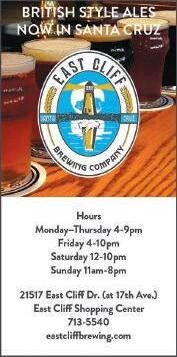

334D Ingalls Street • 831.471.8115 www.westendtap.com

Ask any Santa Cruz parent who appreciates food and drink where to go for happy hour with the kiddos, and they will immediately say West End. Adults and kids alike can’t get enough of the duck fat popcorn, fried calamari and flatbread pizzas, all amazing deals during the happiest of hours. But a visit to this remarkably designed restaurant at any time will not disappoint, with a lengthy and diverse menu and an even longer list of craft beer, cider and wine options.
e outdoor patio is perfect for people watching amidst the bustling Swift Street Courtyard. Open Su– 11:30am–9:30pm, F–Sa 11:30am–10pm.
SEASIDE
Gusto
1901 Fremont Boulevard 831.899.5825 • www.gustopizzeriapasta.com
Gusto owner Denis Boaro, a partner in Carmel’s Basil Seasonal Dining and a native of Northern Italy, named the restaurant for the Italian word for taste and his enthusiasm for delivering delicious rustic Italian food and great service can be seen in the happy faces of his diners. e bright red-tiled, woodfired oven just inside t he entrance both sets the restaurant’s festive tone and produces terrific pizzas. Pastas are from Sand City’s Bigoli pasta and are made from organic flours. Open daily 11:30am–2:30pm and 4:30–9pm.

www.ediblemontereybay.com 65

Edible Monterey Bay Summer 2016 LOCAL SOURCE GUIDE

ese businesses offer some of the best local, seasonal and sustainable products in the region. ey also advertise in Edible Monterey Bay, supporting our mission and enabling us to provide this magazine to you for free. Please drop by and thank them with your business!
BANKS AND CREDIT UNIONS
Santa Cruz County Bank
7775Soquel Drive, Aptos 831.662.6000| sccountybank.com
819Bay Ave., Capitola | 831.464.5300
720Front St., Santa Cruz | 831.457.5000
4604Scotts Valley Drive, Scotts Valley 831.461.5000
595Auto Center Drive, Watsonville | 831.761.7600
A leading community business lender and full-service bank of choice for locals.
BARS AND LOUNGES
My Attic 1937
414Alvarado St., Monterey 831.647.1834| myattic1937.com
Historic lounge specializing in classic cocktails where one can sit and experience Monterey—history, heritage and hospitality!
BREWERIES AND TAPROOMS
See also our 2016 map of regional breweries and taprooms between pages 32 and 33.
East Cliff Brewing 21517East Cliff Dr., Santa Cruz 831.713.5540
Neighborhood brewery specializing in British style, Cask conditioned ales.
East End Gastropub 1501 41st Ave., Santa Cruz 831.475.8010 | eastendgastropub.com
Local gastropub serving handcrafted food, beer and wine.
New Bohemia Brewing Co. 1030 41st Ave., Santa Cruz 831.350.0253 | nubobrew.com
A Bohemian and Bavarian-influenced microbrewery in Santa Cruz’s Pleasure Point neighborhood.
Peter B’s Brewpub
2 Portola Plaza, Monterey 831.649.4511 | portolahotel.com

Monterey’s first craft brewery features delicious, locally brewed beer and an innovative menu including vegetarian and gluten-free options.
Santa Cruz Mountain Brewing 402 Ingalls St., Ste. 27, Santa Cruz 831.425.4900 | santacruzmountainbrewing.com
An award-winning, certified-organic craft brewery featuring wildly imaginative seasonal beers, hard ciders, draught root beer and kombucha.
West End Tap & Kitchen 334D Ingalls St., Santa Cruz 831.471.8115 | westendtap.com
Local gastropub serving handcrafted food, beer and wine.
BUILDERS AND DESIGNERS
Dina Clark Design 831.466.9843| dinaclarkdesign.com
A Central Coast graphic design studio for logos, labels, illustrations and websites.
Monterey Bay Builders Inc. P.O. Box 366, Carmel Valley 831.659.9110| montereybaybuildersinc.com
Since 1989, Eric Barstad has successfully taken on ambitious and complex projects, delivering the highest level of general contracting and construction management services for his clientele.
CATERING
Aqua Terra 529Central Ave., Pacific Grove 831.657.9790| aquaterraculinary.com
Fresh and seasonal food ideas, rooted in sustainability.
Carried Away 7564Soquel Drive, Aptos 831.685.3926| carriedawayfoods.com
Seasonally driven and organic prepared foods and catering operating for 25 years in the Aptos Center.
Michael’s Catering
445 Reservation Road, Marina 831.884.2400 | michaels-catering.com
A premier catering company serving the tri-county Monterey Bay area for more than 25 years.
EDUCATION AND NONPROFITS
Habitat for Humanity/ReStore
719Swift St., Santa Cruz 831.824.4704| habitatsc.org
A nonprofit home improvement store and donation center offering new and gently used furniture, home accessories, building materials and appliances to the public. Proceeds build affordable homes, community and hope locally.
90.3 KAZU
100 Campus Center, Building 201, Room 317, Seaside | 831.582.5298 | kazu.org Public radio for the Monterey Bay area.
MEarth at the Hilton Bialek Habitat 4380 Carmel Valley Road, Carmel 831.624.1032 | mearthcarmel.org
MEarth is a Carmel Valley-based environmental nonprofit organization that is growing the next generation of environmental leaders through education, collaboration, partnerships and community action.
Quail Hollow Kitchens
235 Crown Drive, Ben Lomond 831.609.6226 | quailhollowkitchens.com Specializing in courses for the home cook including artisanal recipes, as well as French and American classics using homegrown and locally farmed organic herbs, vegetables and eggs.

www.ediblemontereybay.com 67
EVENTS
Ag Against Hunger Farm-to-Table Dinner Series
July–October; watch website for details. 831.755.1480| agagainsthunger.org
Ag Against Hunger alleviates hunger by channeling fresh surplus produce from farms to food banks and schools.
CampVintage June118am–4pm
EarthboundFarm’sFarmStand 7250CarmelValleyRoad,Carmel 831.375.6546|campvintage.org
eplacetoscoutfortreasures,fromrusticantiquesto 20th-centruycool.
FARMS, RANCHES, CSAS AND CFSS
EarthboundFarm
Retail:7250CarmelValleyRoad,Carmel 831.625.6219|ebfarm.com
ecountry’slargestorganicgrower,EarthboundFarm hasbeendeliveringdelicious,cleanproducetothelocal communityformorethan30years.
Inzana Ranch

Online and at the Pacific Grove Farmers’ Market, Mondays 3–6pm 855.687.6887 | inzanaranch.com
A 30-year-old, certified-organic family farm growing a diverse array of tree fruits and nuts.
Live Earth Farm
Watsonville based, with a new farm stand 10am–3pm Saturdays at 1275 Green Valley Road and CSA pickup throughout the Monterey Bay and South Bay regions. 831.763.2448 | liveearthfarm.net
Committed to sustainable food through a CSA, farmers’ markets and on-farm farm stand and education.
Morris Grassfed Beef
CSM, at markets and online 831.623.2933 | morrisgrassfed.com
A provider of locally grown grassfed beef, fostering healthy relationships between people, land, animals and food.
Real Good Fish
CSF, Monterey and Santa Cruz counties 831.345.5153 | localcatchmontereybay.com
A community-supported fishery connecting local fishers and sustainable seafood consumers.
GREENPRODUCTSANDSERVICES
Blade Tech 831.917.1330| bladetechusa.com
Professional knife sharpening services for business and home kitchen; also offering high-quality knives and accessories for purchase.
EcoCarmel
SanCarlosbetween7thand8th, Carmel-by-the-Sea 831.624.1222|ecocarmel.com
EcoCarmelisageneralstoreforplanet-andpeoplesafeproductsforyourhomeremodelingandfamily needs.
MRWMD
14201 Del Monte Blvd., Marina 831.384.5313 | mrwmd.org
Visit the website for a complete schedule of disposal and recycling services, workshops and home composting supplies available at Last Chance Mercantile.
Ringlets & Roots–Kristen King
240 Main St., Salinas 831.905.4242 | ringletsandroots.com
Where curls and color meet an expert in a “green” salon.
Solar Technologies
705 N. Branciforte Ave., Santa Cruz 831.421.0440 | solartechnologies.com
Local solar energy system provider featuring efficient technology, design and installation for your home or business.
HEALING AND WELLNESS
Acubloom 833CassSt.,Monterey 831.383.9652|acubloom.com
Healingsimply,simplyhealingwithKristanRoth,a healerwithmorethan20yearsofexperiencein acupunctureandanumberofothermodalities.
e WellNest Skin & Body

240 Main St., Salinas 831.601.0844 | yourskinswellness.com
A holistic wellness and skin care center offering massage, pain and stress management, facials and waxing.
HOTELS AND RESORTS
Bernardus Lodge & Spa
415W. Carmel Valley Road, Carmel-by-the-Sea 831.658.3400 | bernarduslodge.com
Located in the heart of sunny Carmel Valley, Bernardus Lodge & Spa is an elegant and intimate luxury resort offering renowned dining and spa experiences and a 10acre on-site estate vineyard.
Hyatt Carmel Highlands 120 Highlands Drive, Carmel 831.620.1234 | highlandsinn.hyatt.com
Seaside hotel and oceanfront retreat that seamlessly blends the amenities of a luxurious resort with the refined charm of rustic Big Sur.
Hyatt Regency Monterey 1 Old Golf Course Road, Monterey 831.372.1234 | monterey.hyatt.com
Located on Del Monte Golf Course amid 22 beautiful acres of Monterey pines, this hotel also offers a spa and close proximity to Monterey Airport and the city center.
L’Auberge Carmel
Monte Verde Street and 7th Avenue, Carmel-by-the-Sea 831.624.8578 | laubergecarmel.com
A romantic, full-service boutique Relais & Chateau hotel within walking distance of all that Carmel-by-theSea has to offer, including the iconic Carmel Beach.
Monterey Plaza Hotel & Spa
400 Cannery Row, Monterey 831.920.6710 | montereyplazahotel.com
At Monterey Plaza Hotel & Spa you’ll be able to enjoy the best of Northern California such as the Monterey Bay Aquarium, historic downtown Monterey and Fisherman’s Wharf, world-class golfing at Pebble Beach, shopping in Carmel, wine tasting in Carmel Valley and the memorable Big Sur coastline.
Portola Hotel & Spa
2 Portola Plaza, Monterey 831.649.4511 | portolahotel.com
A relaxing retreat in historic Monterey surrounded by unique shopping, fine dining, spectacular coastal trails and beaches.
68 edible monterey baysummer 2016
Post Ranch Inn/Sierra Mar Restaurant
47900 Hwy. 1, Big Sur 831.667.2800 | postranchinn.com
A “sanctuary for the soul” offering the ultimate in luxurious coastal Big Sur lodging, including breathtaking views and exquisite dining.
QuailLodge&GolfClub
8000ValleyGreensDrive,Carmel 831.620.8808|quaillodge.com
QuailLodgefeaturescomfortablelodging,an18-hole championshipgolfcourse,fitnesscenterandsustainablysourced,seasonalcuisineontheMontereyPeninsula.
Sorensen’s Resort

14255 Hwy. 88, Hope Valley 530.694.2203 | sorensensresort.com
A historic all-season resort with rustic cabins and outdoor activities located in majestic Hope Valley at Lake Tahoe.
NURSERIES, LANDSCAPING ANDGARDENSUPPLIES
DIG Gardens
420Water St., Santa Cruz 831.466.3444| diggardensnursery.com

A garden shop unlike any other: organic, bohemian, modern style from Santa Cruz.
Gardner & Bloome
OMRI-listed organic fertilizers and soils from Kellogg Garden Products distributed locally by:
Aptos Landscape Supply
5035 Freedom Blvd., Aptos 831.688.6211 | aptoslandscapesupply.com

Del Rey Oaks Gardens 899 Rosita Road, Del Rey Oaks 831.920.1231 | drogardens.com
Drought Resistant Nursery 850 Park Ave., Monterey 831.375.2120 |droughtresistant.com
e Garden Co. 2218 Mission St., Santa Cruz 831.429.8424 | thegardenco.com
Griggs Nursery
9220 Carmel Valley Road, Carmel 831.626.0680 | griggsnursery.com
Hidden Gardens Nursery 7765 Soquel Drive, Aptos 831.688.7011

M. J. Murphy Lumber
10 E. Carmel Valley Road, Carmel Valley 831.659.2291 | facebook.com/M.J.MurphyLumberHardware

Martin’s Irrigation
420 Olympia Ave., Seaside 831.394.4106 | martinsirrigation.com
Mountain Feed & Farm 9550 Hwy. 9, Ben Lomond 831.336.8876 | mountainfeed.com
e Plant Works 7945 Hwy. 9, Ben Lomond 831.336.2212
San Lorenzo Garden Center 235 River St., Santa Cruz 831.423.0223 | sanlorenzolumber.com/gardencenter
Scarborough Gardens 33 El Pueblo Road, Scotts Valley 831.438.4106 | scarboroughgardens.com
Seaside Garden Center 1177 San Pablo Ave., Seaside 831.292.0400 | seasidegardencenter.com
Valley Hills Nursery 7440 Carmel Valley Road, Carmel 831.624.3482 | valleyhillsnursery.net
Mountain Feed & Farm Supply 9550 Hwy. 9, Ben Lomond 831.336.8876 | mountainfeed.com
Mountain Feed & Farm Supply is a unique and complete organic farm, garden, homestead, pet, gift and housewares store located in the Santa Cruz Mountains.
MRWMD 14201 Del Monte Blvd., Marina 831.384.5313 | mrwmd.org
e MRWMD offers premium quality, OMRI-listed organic compost as well as topsoil and wood chips by the truckload at the district scales or bag-your-own at its Last Chance Mercantile shop.
Native Revival Nursery 2600 Mar Vista Drive, Aptos 831.684.1811 | nativerevival.com Growing, selling and installing California native plants on the Central Coast for more than 24 years.
Plant Landscape Design 2801 S. Main St., Soquel 831.476.1895 | plantlandscapedesign.com Full-service landscaping company: design, build, maintain, serving greater Monterey Bay.
Terra Nova Ecological Landscaping Santa Cruz 831.425.3514 | terranovalandscaping.com
A full-service ecological landscaping company providing design, installation and maintenance of beautiful living systems for public and private lands.
PRODUCE PACKERS, SHIPPERS, AND DISTRIBUTORS
Pajaro Valley Fresh 320 Industrial Road, Watsonville 831.722.3805 | maria@pajarovalleyfresh.com
irty-three-year-old Pajaro Valley Fresh offers wholesale fresh fruits and vegetables from the heart of the Pajaro Valley.
RECREATION
Chardonnay Sailing Charters
704 Soquel Ave., Santa Cruz 831.423.1213 | chardonnay.com Excursions aboard the Chardonnay II are perfect for any age group and fun for everyone from seasoned sailors to first-time adventurers.
www.ediblemontereybay.com 69
RESTAURANTSANDCAFÉS
See our Dine Local Guide, p. 55 and our 2016 guide to the region’s breweries and taprooms, between pages 32 and 33.
SPECIALTYFOODPURVEYORS

Earthbound Farm’s Farm Stand and Organic Kitchen 7250Carmel Valley Road, Carmel 831.625.6219| ebfarm.com
Serving delicious organic, handcrafted food, gourmet groceries and unique gifts, as well as fresh produce and flowers.
FoodLounge
1001CenterSt.,SantaCruz scfoodlounge.com
Adynamic,community-mindedvenuefeaturingpopupfoodexperiencesfrommanytenant-collaboratorsincluding:
Ashby Confections 831.454.8299 | ashbyconfections.com
Fogline Farm 831.212.2411 | foglinefarm.com
Kickin’ Chicken 818.458.8552 | facebook.com/kicknchickenSC La Marea of the Sea 831.331.3432
Tanglewood 831.713.8983 | facebook.com/Tanglewood.SC
Lifestyle Culinary Arts lifestyleculinary.com
LionFish SupperClub lionfishsc.com
Ocean 2 Table getocean2table.com

New Leaf Community Markets 1134 Pacific Ave., Santa Cruz 831.425.1793 | newleaf.com
1101 Fair Ave., Santa Cruz | 831.426.1306 6240 Hwy. 9, Felton | 831.335.7322 13159 Hwy. 9, Boulder Creek | 831.338.7211 1210 41st Ave., Capitola | 831.479.7987
150 San Mateo Road, Half Moon Bay | 650.726.3110 Our mission is to nourish and sustain the community by offering the best, most wholesome food on the planet.
e Quail & Olive
3 Pilot Road, Carmel Valley 831.659.4288 | quailandolive.com
A boutique featuring quality, California olive oils and vinegars, as well as natural skin care products and cookbooks for better health.
Santa Cruz Community Farmers’ Markets 831.454.0566 | santacruzfarmersmarket.org Lincoln and Cedar streets, Santa Cruz 120 Russell Ave., Felton 21511 E. Cliff Drive, Live Oak
360 Kings Village Road, Scotts Valley 2801 Mission St., Santa Cruz
For 25 years Santa Cruz Community Farmers’ Markets (SCCFM) has been committed to your health and to the health of the local economy.
Shopper’s Corner
622 Soquel Ave., Santa Cruz 831.423.1398 | shopperscorner.com
Santa Cruz’s oldest and friendliest family-run market.
Star Market
1275 S. Main St., Salinas 831.422.3961 | starmkt.com
An independent grocer featuring the freshest, best tasting and finest selection of food in the Monterey Bay area; locally produced foods and wines are a specialty.
Stewart & Jasper Orchards
Monterey Plaza Hotel, 400 Cannery Row, Ste. C, Monterey | 831.375.6887 | stewartandjasper.com
A family-owned almond grower committed to quality, eco-friendly practices, water conservation and customer service.
Stone Creek Kitchen
465 Canyon del Rey Blvd., Monterey 831.393.1042 | stonecreekkitchen.com
Our mission is to create a unique educational and culinary destination for epicureans on the Monterey Peninsula.
Troia Foods
801 Foam St., Monterey 831.375.3354 | troiafoods.com
A local dairy and fine food distributor for businesses.
Vertigo Coffee Roasters
81 Fourth St., San Juan Bautista 831.623.9533 | vertigocoffee.com
Specialty coffee roasters that also feature wood-fired cooking and craft beers.
e Wharf Marketplace
290 Figueroa St., Monterey 831.649.1116 | thewharfmarketplace.com
Monterey County’s fresh food destination, featuring the “bounty of the county”—locally produced provisions at their seasonal best.
SPECIALTY SHOPS AND GALLERIES
Annieglass
310Harvest Drive, Watsonville 831.761.2041x21 | annieglassstore.com
Locally designed and handmade slumped-glass plates, bowls and serving dishes that add famed art and style to the dining room.
Botanic and Luxe
701A Front St., Santa Cruz botanicandluxe.com
Botanic and Luxe is a lifestyle store in downtown Santa Cruz featuring home décor, gifts and botanicals.
La Sirena Nouveau & Vintage
328D Ingalls St., Santa Cruz 831.427.2766 | lasirenaantiques.com
La Sirena has assembled the most eclectic selection of wonderful treasures, decor and boutique clothing, all nestled on Santa Cruz’s hip Westside.
Last Chance Mercantile/MRWMD
14201 Del Monte Blvd., Marina 831.264.6900 | mrwmd.org
e only reuse store at the entrance to a landfill in the U.S. where one person’s trash truly becomes another’s treasure, Last Chance Mercantile provides convenient dropoff for reusable goods and an ever changing inventory of affordable, preowned and salvaged items.
70 edible monterey baysummer 2016
Madrigal

Carmel Plaza, Mission between Ocean and 7th, Carmel-by-the-Sea | 831.624.3477
Offering attire for men and women who prefer a classic look.
Pacific Trading Co.
1224 Pacific Ave., Santa Cruz | 831.423.3349
504C Bay Ave., Capitola | 831.476.6109 facebook.com/pages/pacific-trading-co/65027935549
Independent, local, family-owned women’s apparel boutique.
TOURIST INFORMATION AND SOUVENIRS

Destination Salinas/Salinas Valley 411Visitor Center, 222 Main St., Salinas 831.594.1799| destinationsalinas.com
Destination Salinas offers everything about the area for visitors and locals alike: information, maps, souvenirs, T-shirts, local art and much more—plus we are a green business!
WINERIES AND TASTING ROOMS
Albatross Ridge Tasting Room
Mission Street between Ocean & 7th Avenues, Carmelby-the-Sea 831.402.8992 | albatrossridge.com
Pinot Noir and Chardonnay wines that express their place of origin just seven miles from the Carmel Coast and made from organically grown grapes.
Beauregard Vineyards
10 Pine Flat Road, Santa Cruz 831.425.7777 | beauregardvineyards.com
Sustainably produced wines expressing the terroir of the Santa Cruz Mountains through minimal impact winemaking.
Carmel Valley Wine Experience cvwineexperience.com
A group of tasting rooms offering a unique way to experience wines in the Carmel Valley sunshine.
Members include:
Bernardus Winery
5 W. Carmel Valley Road, Carmel Valley 831.298.8021 | bernardus.com
Bunter Spring Winery
9 DelFino Place, Ste. 102, Carmel Valley 202.744.1343 | bunterspringwinery.com
Chesebro Wines
19 E. Carmel Valley Road, Carmel Valley 831.659.2125 | chesebrowines.com
Cima Collina
19 E. Carmel Valley Road, Carmel Valley 831.620.0645 | cimacollina.com
e Coastview Vineyard
19 E. Carmel Valley Road, Carmel Valley 831.298.7521 | coastviewvineyard.com
Holman Ranch
19 E. Carmel Valley Road, Carmel Valley 831.659.2640 | holmanranch.com
Idle Hour Winery
9 DelFino Place, Carmel Valley 831.298.7526 | idlehourwinery.com
Jarman Tasting Room
18 W. Carmel Valley Road, Carmel Valley 831.298.7300 | jarmanwine.com
Joullian Vineyards
2 Village Drive, Carmel Valley 831.659.8100 | joullian.com
Joyce Vineyards
19 E. Carmel Valley Road, Carmel Valley 831.659.2885 | joycevineyards.com
Mercy Wines
40 W. Carmel Valley Road, Ste. A, Carmel Valley 831.659.4321 | mercywines.com
Parsonage Family Winery
19 E. Carmel Valley Road, Carmel Valley 831.659.7322 | parsonagewine.com
Hallcrest Vineyards
379 Felton Empire Road, Felton 831.335.4441 | hallcrestvineyards.com
A family-owned business that takes pride in producing original, organic wines and hard ciders with a taste of the Santa Cruz Mountains.
Holman Ranch Vineyards Tasting Room
19 E. Carmel Valley Road, Carmel Valley 831.659.2640 | holmanranch.com
Featuring diverse wines with complex flavors reflective of the Carmel Valley terroir and frequent special events.
Jarman Tasting Room
18 W. Carmel Valley Road, Carmel Valley 831.298.7300 | jarmanwine.com
Holman Ranch’s Jarman Wine is a new premium Chardonnay and Pinot Noir label. $1 from each bottle sold benefits the Alzheimer’s Drug Discovery Foundation.
McIntyre Tasting Studio
169 Crossroads Blvd., Carmel 831.626.6268 | mcintyrevineyards.com
Small lot wines that embody the mountainous, maritime terroir.
Percheron-McFarland 46 4th St., Gonzales 831.675.2311 | percheron-mcfarland.com
Dedicated to a world-famous legacy of excellence in California Pinot Noir and Chardonnay.
Scheid Vineyards Tasting Room
San Carlos at 7th, Carmel-by-the-Sea 831.626.WINE | scheidvineyards.com
Scheid Vineyards Winery & Tasting Room
1972 Hobson Ave., Greenfield 831.386.0316 | scheidvineyards.com
Forty years of success in family winemaking in Salinas Valley.
Storrs Winery
303 Potrero St., Ste. 35, Santa Cruz 831.458.5030 | storrswine.com
Handcrafted wines made in the Santa Cruz Mountains; downtown Santa Cruz tasting room open daily.
Wrath Wines
Carmel Plaza, Ocean Ave, Carmel-by-the-Sea 831.620.1909 | wrathwines.com
Producer of site-driven Pinot Noir, Chardonnay, Syrah and Sauvignon Blanc from its sustainably certified vineyard and other respected properties in the Santa Lucia Highlands.
www.ediblemontereybay.com 71
LUNCH IN LISBON
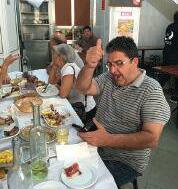
A reminder that the soul of a place is found through its food—and its people
STORY AND PHOTOGRAPHY BY PATRICE VECCHIONE
Strolling up the wide boulevard of Lisbon’s Rua Augusta from the coastline into the heart of the city, feeling increasingly hungry and verging on cranky, my husband Michael and I could have easily been led by loud barkers into one of the tourist restaurants conveniently situated along the way.
We pressed on, hoping for something authentic. e crowd at a hole-in-the-wall restaurant off of Rua da Madalena on a mere slip of a street told us that this was the place. Still, we had no idea that one of the finest afternoons ever was about to be ours.
It wasn’t until later that I learned Zé dos Cornos is considered one of Lisbon’s best-kept secrets. And it wasn’t just the food, although delicious, that made the afternoon last summer so memorable. It was the ties we formed there, and the reminder of the ultimate connector that food can be—that sharing a meal can make friends out of strangers and locals out of us all, no matter where we’re from or where we find ourselves.
e tiny restaurant serves family style at a few communal tabl es. We were seated beside three jovial men who talked nonstop. To my ear, Portuguese has the most beautiful sound of any language I’ve heard, but I don’t speak or read it. When Michael and I looked up at the chalkboard menu behind the open-facing kitchen, we were stumped.
So I leaned over to the stranger beside me and asked, “Excuse me, do you speak English?” He smiled one of those smiles that make a person wholly happy, shrugged and said, “A little.”
“What do you recommend?” I asked.
“ey serve fish and they serve meat,” he said. “e meat is better.”
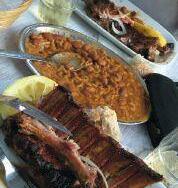
at’s where it started.
e three friends filled our glasses with delicious Portuguese vinho verde, a light, crisp, slightly effervescent wine. When the waiter arrived,
Michael pointed to our neighbors’ plates and said, “We’ll have the same, please.”
We dined on full-flavored, just garlicky-enough, traditional grilled pork ribs served with rice and beans and a green salad. Once we’d begun chatting with our new dining companions, there seemed to be no language barrier at all—the conversation never stopped.
Employees of Portugal’s version of our TSA, Rui, António and João get together for lunch whenever they have a mutual day off. ey shared their dess ert with us—a creamy custard called doce de bolacha. I wanted more, but out of politeness, restrained myself.
João asked, “What are you doing next?”
“No plans,” replied Michael.
“en you’re coming with us!” Rui said.

“You’ve got to try ginja,” António said.

ey wound us through narrow streets and across wide ones until we arrived at a tiny storefront bar.
All together our hosts said, “Your money is no good here!”
e bartender lined up five small glasses of a deep red liquid. Ginja is a cherry liqueur; at the bottom of each glass was a single liquordrenched cherry.
Food and drink and convivial strangers—is there really such a thing? Sharing a meal made intimates out of the men sitting next to us, and they introduced us to the local fare of Lisbon. We dined as if we belonged there, because suddenly we d id.
I’m sticking close to home this summer. But when I dine out in Carmel, Seaside or Santa Cruz, I’ll keep my eye out for Rui, António and João—or for Pauline, Jane and Elizabeth, knowing there’s no need to go to the ends of the earth to make new friends over lunch! Maybe this year I’ll get to introduce travelers to the pleasure of our local fare.
72 edible monterey baysummer 2016
LAST CALL





















































































































 BY JOHN COX
BY JOHN COX
















































 Courtesy Emily omas, proprietor, e Cremer House in Felton
Courtesy Emily omas, proprietor, e Cremer House in Felton

































































































































